WHISPERS
OF The Pyramus & Thisbe Society

ISSUE 52
p04
NATASHA DEMIRBAG
Chairman’s Column FAREED F FETTO p06
Exploring the possibilities
HIS HONOUR EDWARD BAILEY
p14
50 Years with Party Walls
DAVID MOON
p24
Is the Party Wall etc wAct 1996 optional?
MATTHEW HEARSUM
p28
Is the Party Wall etc Act 1996 optional?
THE SOCIETY’S VIEW
p38
Risks, Costs and Pitfalls of seeking injunctions
HIS HONOUR EDWARD BAILEY
p09
From the vaults
LAWRENCE HURST
p20
Letter to the editor
p27
The Right to reply
MATTHEW HEARSUM
p31
Dealing with the bloodyminded building owner; Party Structure Notices, and going to Court
HIS HONOUR EDWARD BAILEY
p44
Readers Wall
CHRIS TOMLIN
2 The Pyramus & Thisbe Society Contents ISSUE
52 p03 Welcome
Welcome to the Spring edition
Natasha Demirbag FTPS

FOLLOWING HOT ON THE HEELS OF THE Winter 2023 issue (Issue 51) we have now sprung a Spring edition to share with you. We are fortunate to be able to bring you a copy of Mathew Hearsum’s recent article that was published in the Estates Gazette towards the end of last year and a letter to the Editors that was received in response to the publication of Matthew’s article. Matthew’s article has prompted much discussion within the membership of the Society and so the management team have decided to share their own personal thoughts on the matter within Whispers.
We have three articles for publication by retired judge His Honour Edward Bailey, which continue along the legal theme. They deal with the “Bloody-Minded” Building Owner and also the risks, costs and pitfalls of seeking
injunctions. Chris Tomlin has kindly shared with us photos of a large deep basement excavation project in central London, and we also have an article from David Moon.

natasha@natashademirbag.com
3 The Pyramus & Thisbe Society
Chairman’s column
Fareed F Fetto FTPS

PREFACE
The address, which, on the occasion was abridged due to time restrictions, has now been modified to read more as an article than an oral address. Items omitted have been reinstated.
FELLOW FELLOWS
“The Intended Business of the Society Prescribed by the Constitution”
Someone somewhere has placed confidence in me to the extent that I am capable of speaking on an austere subject such as this.
I am still recovering from the fact that anyone should have voted me in as chairperson during this very significant milestone: the transition into a Society. I take this opportunity to honour Shirley Waldron, the then outgoing
chairperson, who should have been the chairperson at transition but was obliged to step down due to extenuating personal circumstances.
Now, my mission is to continue to team up with others to build upon the foundation upon which the transition has been made.
Foundations are important, and while engineering-based party wall surveyors and myself feel quite at home taking an interest in foundations, all party wall surveyors take an interest in cracks!
We do not want them, but we are happy to record them –they give our schedules of condition a certain sense of ‘value for money’, compared with the case of a newly decorated or well-maintained building leaving us bereft of anything to record!
Cracks can develop in buildings for various reasons, even buildings on sound foundations, while, by contrast, cracks are very likely to develop in buildings built on weak inadequate foundations.
Get the foundation right, and you increase the chances of the building being crack-free!
So, here, after my short lesson on foundations brought to you absolutely free of charge, is the point I am making –just in case it has been missed.
The foundation of the Society is, of course, the Constitution, we are the builders, building in accordance with an award, method statements, and, of course, applicable regulations.
“Wait,” you might say, “I never wrote the constitution, but now I find myself being asked to build upon it” –
My friend, if you were at the original inaugural Fellowship meeting, and you watched, whether voting for or against, the constitution come into being, you became responsible for it!
On the happy side, I remind us all that we are the Fellowship. We are the boss. We are the champions!
As such we have the power to change anything, even if the concrete has hardened!
Friends, we have no power if we are not present. By that, I mean present in mind intent, activity, participation, agreement, disagreement, debate, discussion, production, promotion, collaboration cooperation enthusiastically, being US and US instead of US and THEM!
No more talk of ‘London-centric’. We are one Society with many Branches who are invited to take part in its business; sources are available to all, the steering wheel is available to all. The door is wide open and you and I are invited to enter.
4 The Pyramus & Thisbe Society
Any idea of there being some elite group, lording it over the membership, doing whatever it likes is not part of the Society culture and if any such thing exists, call it out, and come, join me and others in eradicating it.
Any idea of feeling separated and isolated from the membership, the business, or the governing of the Society is in stark contradiction of our values; such an idea should not be entertained by anyone.
Today, let’s continue to build the Society and make it what we would like it to be!
I would like to thank everyone of you, if I may do so on behalf of eachother, and on behalf of the Society: Thank you, thank you for the effort and hard work you have, and continue, to put in to the Society, and for those who found it practicable to attend, thank you for being here, and for those who did not, thank you for being there [that is, online]!
Of greater significance today, as we roll on towards our 50th Anniversary celebrations which we will celebrate in more depth and breadth, is the deep gratitude and honour we owe to certain of us who have spent years, even decades, working for the establishment, development and future of our organisation whether originally as a Club, or at present as a Society, in particular the two vision-bearers, Andrew Schofield and Stuart Birrell, and significantly Graham North. Both the vision-bearers declare that they could not have achieved what they did without Graham’s support and encouragement.
Today the Management Board is saying good-bye to some of the fellow champions who have worked hard both for the Club and the Society, as I have said, for many years, and although we will, no doubt, hang on to their apron strings for a while, we will have to release them as those deserving of a break, and, of course, of honour, and get on with the business of the Society even though it would be a hard act to follow!
So, what is the business of the Society?
Section 4.1 of the Constitution includes the words:
“……the object of the Society is to promote, maintain, improve and advance the education, standards of practice and awareness of members in matters relating to Party Walls and allied subjects especially those governed by the Party Wall etc. Act 1996 and subsequent party wall legislation.”
Under this general objective statement, we are working on the various aspects as you heard in the earlier part of this meeting.
What does it not say?
Allow me please to pick this point up and then bury it for good!
It does not say “compared with” !
We are not in competition with other organisations; we are not disrespectful of them neither do we look down upon them. We have our objectives and they have theirs. Some may converge and some may diverge. Even if we were running against them, which we are not, remember, the runner looking left and right reduces their chances of running in a straight line!
Let’s look straight ahead, minding our own business, setting the gold standard, and doing it well! To me, the gold standard speaks to me more than all considerations. Remember, it was implied in the old Club motto.
We are together focussed on the objective.
Here are some key motivating words from the Constitution.
Notice, they are all words of ACTION!
Promote
Maintain
Improve
Advance I like this one!
In connection with:
Education Standards
Awareness To this I would add, not only members, but the public at large
How can we achieve this …… “business”?
Promote, maintain, improve, advance…?
You are the bosses, the Management Board is the implementer of the objectives, but it is the Fellowship which determines them. I encourage you to play your part, and I say to those who are: thank you.
Your contribution is needed and valued.
Tell us, Fellowship, what needs to be done and let’s make the changes and advance!
How radical?
As radical as you like!
As mentioned in my formal report, I see plenty of positives which have been achieved during the year, but how should we develop, and will you, the Fellowship, all the Branches, take part and pull with us?
How can we improve what we have done?
What future should we map out for the Society –what further objectives, what inking in of existing objectives should we put our hand to?
How would you complete this sentence:
“I am proud to be a member of the Society because…..”
Here is what I would say:
“I am proud to be a member of the Pyramus & Thisbe Society because it is a fellowship of well-respected, wellexperienced and newly-practising mutually courteous members with like interests and vision, and because the Society is rooted in both the formation of the current Act, and a wealth of knowledge and experience I can freely draw from. It provides good resources for me to maintain and increase my knowledge of party wall and associated matters, it is enthusiastically promoting its objectives and it is good fun to be part of it”
You will be pleased to know that I am coming to the end of my address, and in so doing, I encourage you to express your views freely as we embark on an open discussion, questions and answers (if we know them!) and suggestions.
[The floor was then opened for discussion]
fetto@fareedfetto.co.uk
5 The Pyramus & Thisbe Society
Exploring the possibilities
His Honour Edward Bailey

1What can the party wall surveyor do if it is apparent that there is something wrong with a party wall, but an external inspection does not reveal the problem? The answer in most cases will be to open up and investigate. But will the 1996 Act allow it?
2
In the rather ancient case of Hobbs, Hart & Co v Grover [1898] 1 Ch 11 the Building Owner had purchased a house at 75 Cheapside in the City of London. The BO wanted to pull building down and rebuild it. The wall between 75 and 76 Cheapside was accepted to be a party wall, but the BO was not certain of the condition of the wall and whether, and if so to what extent, that wall might require work. The BO’s surveyor decided to serve a party structure notice (PSN) under s.90 of the London Building Act 1894 which simply recited the whole of s.88 of the 1894 Act, the predecessor to what is now s.2(2) of the 1996 Act. (This appears to have been a general approach at the time). The Adjoining Owner objected to the notice, complaining that it did not state “the nature and particulars of the proposed work”. In response the BO argued that it was not possible for him to give a detailed notice before he knew the condition of
the party wall, and this would not be known until after the works had begun.
3
The matter came before Channell J who adopted a very pragmatic approach to the dispute. The Learned Judge decided to uphold the PSN on the BO’s undertaking not to act on any part of the notice which involved repair, pulling down, rebuilding or raising the party wall without first giving the AO inspection of his plans under an amended PSN, a month to serve a counter-notice, and a further period of 10 days to appoint an adjoining owner surveyor who could then resolve any dispute with the building owner’s surveyor in the usual way.
4
This was all too practical for the Court of Appeal. Finding that the provisions of the 1894 Act did not allow such an approach the Court overturned the Judge’s decision. The Court’s judgment (presumably after setting out the basic facts) extends to the whole of two sentences! Given by Lindley MR it reads “In my opinion the notice ought to be so clear and intelligible that the adjoining owner may be able to see what counter-notice he should
6 The Pyramus & Thisbe Society
given to the building owner under s.89. This is the key to whole matter.” Chitty and Vaughan Williams LLJ concurred. Usefully, the Law Report records questions posed by their Lordships in the course of counsel’s argument, and Chitty LJ’s view on the matter appears from his question “Should not the notice be such as will enable the adjoining owner to judge whether he shall consent or object to the proposed works?”. This is perhaps a sounder basis for requiring detail in the PSN than the possibility of service of a counter-notice.
5
Intriguingly the Law Report records “Ultimately the defendant (BO) consented to amend his notice in accordance with the view taken by the Court.” Quite how he was able to do this is not clear; perhaps the BOS took the expedient of fearing the worst so as to obtain an Award which would cover anything that might have to be done, on the basis that the Award would not be so drawn as to require unnecessary work to be undertaken.
6
120 years later the appeal in Thomas Ash v Shayne Trimnell-Ritchard (19.11.2020) came before HHJ Parfitt sitting in Central London County Court. The problem facing the building owner was a leak in her basement ceiling the cause of which was not at all obvious to the two partyappointed surveyors. One possibility was that there was water ingress as a result of the connection of a side extension to the party wall by the AO, work which should have been authorised by award under the 1996 Act but in respect of which no notice had been served by the AO. But this was simply a possibility, and the party wall surveyors were quite unsure as to the precise cause. The AOS suggested some opening up to explore the source of the leak, but his preferred approach was to engage the services of a ‘damp specialist’ in the hope that such a specialist might ascertain the real cause of the leak.
7
The BOS and the 3S decided however to proceed to an award authorising the following works::
“….. namely
a. Lift, set aside and replace upon completion the decking at the rear of the AO’s extension;
b. Investigate the abutment detailing between the structure at the top of the underlying basement slab and the party wall;
c. Carry out repairs to the joint between the basement slab and the party wall;
d. Repair damp-affected plasterwork and redecorate affected surfaces within the BO’s property, redecoration to the extent required to achieve a reasonable colour match.”
The Award also provided that:
“Following the lifting of the decking described in clause 1(a) above and before carrying out the works described in clause 1(c), carry out such further investigations as are considered
necessary.
“Provide the surveyors with the results of the investigations, a photograph of the area showing the concealed fabric … And obtain their approval of a description of the proposed works and an itemised estimate of cost.”
The essence of the award was therefore an investigation followed by repair as may be found necessary.
The Judge set aside the Award. He observed at [18] that “there is no free-standing right … to carry our exploratory investigations outside of the actual entitlement to carry out work but to investigate if there is an entitlement to carry out work. If Parliament had wanted to grant such an investigatory right then it would have done so expressly. There is a long list of rights in Section 2 and the right to investigate to see whether or not you need to exercise other rights contained in the Act is not one of them, and I do not think that it is ancillary to any of the rights set out in Section 2 or otherwise, nor can it be implied and nor, as a matter of purposive construction, can the Act be said to create or give rise to such a right.”
8
In conclusion, at [21] “The surveyors had no jurisdiction to make this award because the Act does not give them the power to require or allow a party, independent of the exercise of an actual right given by the Act, to investigate and that is what this award purports to do, and that problem, the failure to identify that the award must first determine the right to execute work to which the Act is relevant is a fatal flaw throughout the very difficult to follow wording in this unfortunate and unhappy award.”
9 Is the above a fortunate and happy wording of a judgment?
10
Incidentally, the Judge went further and castigated the surveyors involved for including within the award observations, albeit expressly stated not to form part of the determination, to the effect that the adjoining owner had undertaken work to the party wall without serving notice in accordance with the provisions of the 1996 Act. The award also envisaged that these unauthorised works might have caused the leak (my emphasis). The Judge suggested at [11] that these comments would indicate to any reasonable person reading the award that the surveyors were not carrying out their function, or appeared to be carrying out their functions in a way that would fit their quasi-judicial roles. How far this criticism was merited on the facts is debatable and raises interesting questions, but these are outside the scope of this article.
11
But does the 1996 Act prevent investigatory work? What should the PWS do when uncertain as to what precise work is required? It is to be
7 The Pyramus & Thisbe Society
noted that the rights granted to a building owner under s.2(2) include, at s.2(2)(f) a right “to cut into a party structure for any purpose (which may be or include the purpose of inserting a damp proof course)”. On a plain reading of the Act “for any purpose” surely means just that. Is not investigation a purpose? Investigation is regularly carried out to discover whether and if so what faults may exist in any particular part of a completed building. It is a perfectly legitimate purpose. It is not at all obvious to the author that a BO with genuine concerns as to the state of the party wall should be prevented from investigating quite what the problems are. It might be objected that investigation is not a proper stand-alone purpose, and that “any purpose” must be construed as involving a purpose connected with the Act and, perhaps, in particular connected with s.2(2) rights. The author does not advocate such a construction of the statute, but even if it were adopted it should not prevent investigation where this is necessary. Provided a party structure notice has been served identifying the right(s) under s.2(2) the BO wishes to exercise in the event that particular faults are found, and the notice has been suitably drafted, there should not be any difficulty in accepting investigation as a purpose under s.2(2)(f). In this regard the provisions of s.2(2)(b) may well be helpful. This gives the BO the right “to make good, repair, or demolish and rebuild, a party structure … in a case where such work is necessary on account of defect or want of repair of the structure or wall;”. The combination of (b) and (f) should cover most situations where an investigation is warranted.
12There remains the need to consider the extent of the work which would be allowable under s 2(2)(f) “to cut into a party structure for any purpose”. (Incidentally, s.88(8) of the London Building Act 1894 – see para 2 above – gave the BO the right “to cut into any party structure upon condition of making good all damage occasioned to the adjoining premises by such operation.”) How far can a “cut into” go? Plainly a ‘cut into’ a party structure must fall short of actual demolition, but if the purpose is to investigate a leak or a want of repair, presumably a ‘cut into’ may go as far as is necessary to make the necessary determination. “Cut into” also appears in s.2(2) (j) where the right to cut into an adjoining owner’s wall is permitted to insert a flashing or other weather-proofing of a wall erected against that wall. The context of the right in s.2(2)(j) might suggest that cutting into involves intrusion of a fairly limited extent, but there is no obvious reason why s.2(2)(f) should be interpreted by reference to another freestanding right under s.2(2). The more so because s.2(2)(f) expressly provides that “any purpose” may include the purpose of inserting a damp proof course. In the usual course an effective damp proof course requires a very extensive intrusion into the party structure, well beyond that required by the insertion of a flashing.
13
Ad ditionally to s.2(2)(f) there is s.2(2)(k) to consider. Here the BO’s right is “to execute any other necessary works incidental to the connection of a party structure with the premises adjoining it;”. Note that this right relates to “the connection of a party structure” not to the “connecting of a party structure” and so applies to an existing connection. If there is a leak at or adjacent to the connection of a party structure with adjoining premises opening up to find and remedy the leak would on the face of it come within s.(2)(2)(k).
14
Party wall surveyors tend to be practical people, and the award made in Ash was a practical award. (And I rather doubt justified the harsh words the Judge had for the surveyors involved). But as a cautionary note to surveyors, while being practical do keep an eye on the Act. Make sure that you work within it. As quoted in the Judgment in Ash it appears that the party structure notice was restricted to the rights afforded s.2(2)(b). If this is the case (and the author cannot be certain not having seen the notice and it not being quoted in its entirety in the Judgment) the surveyors missed a trick. Going back to the Award, see paragraph 7 above, the works at (a) and (d) are questionable as stand-alone works, but it seems to the author that the works at (b) and (c) could have been reworded so as to bring the work within s.2(2)(f) and or (k). Furthermore, neither (a) or (d) would appear to be work expressly requiring an award under the 1996 Act, and could have been included in the award either as part of the “manner of executing” (b) and (c) or as “any other matter arising out of or incidental to the dispute” under s.10(12)(b) or (c). The important thing is that the party structure notice in a case where exploratory works may be necessary does expressly include reference to the rights in s.2(2)(f) and (k).
15
Amendment to the 1996 Act to give the express right to undertake investigatory work to be undertaken would seem sensible. Quite how the amendment should be drafted may be the subject of some debate. For the present however a party wall surveyor should be able to carry out works of investigation in most situations by a careful use of s.2(2)(f) and (k) together with s.2(2)(b) or other rights afforded the building owner in section 2.

clams.tcc@gmail.com CREDIT 8 The Pyramus & Thisbe Society

9 The Pyramus & Thisbe Society From the Vaults
Are there really two walls?
FIND OUT BEFORE YOU DEMOLISH AND AVOID SURPRISES
Lawrance Hurst
AS FIRST PUBLISHED IN WHISPERS 5 – SUMMER 2001
THE ACT IS ALL ABOUT AVOIDING surprises. Perhaps not really “all about” but its primary purpose today, as averred by the Earl of Lytton when promoting the Bill in the House of Lords is to find out about next door so that the works can take into account the interests of the neighbour and be designed, or varied if they are already designed, to minimise the implications for the next door building. Originally, starting in 1189, the party wall provisions were of course enacted to prevent the spread of fire across boundaries, but those essential measures are now enforced by other legislation, such as the Building Regulations, and our Act now deals exclusively with neighbourly issues.
When the works include demolition, one of the most important aspects, perhaps the most important, of those neighbourly issues is establishing the limits of demolition, which sends my rambling down a snake to where I started with my title - are there really two walls? Superficial evidence, such as straight joints on the front and rear elevations and what looks like two parapets may lead you to deduce that there are two walls and that the building owner can demolished the one on his side, leaving the adjoining owners wall intact. However I do urge you to check your deductions thoroughly to establish that there really are two separate and independent walls, each of adequate thickness, before telling the demolition contractor to bash on. Unless you do, you will risk laying open the adjoining owners building, which is a surprise we all wish to avoid.

thicknesses of walls, both party and external, have since time immemorial, or at least in London since the 1667 Act, and elsewhere since local Acts and By-laws laid it down, been determined by the height and length of the wall and the class of building they enclosed. This meant that if the Building Owner wished to add storeys to the top of his building, or take it down and replace it by a more lofty building, he needed not only to raise on the wall, but also to thicken it to bring it out to the thickness prescribed in the Act or the By-laws for the new height. He could of course exercise his right to take it all down and rebuild it to the new height and required thickness, but this would involve laying open and shoring the adjoining building, and no doubt paying substantial compensation to all the adjoining owners and occupiers, so was to be avoided if at all possible.
If he thickened and raised the wall, he would do this by adding a skin of new brickwork, which would inevitably be of different bricks and a different mortar to the existing party wall and so would look to his successors in title and their advisers like another wall built against the existing wall. Thickening is seldom well bonded or tied to the existing wall, but it does follow the wall in and out so there may not be a vertical plane between it and the wall.
The reason for advising this extreme caution is that
At the top of the old wall, the raising may not be on the whole width of the old wall, leaving a step in the wall thickness on the external side which can be mistaken for a parapet, and may even have a brick on edge and tile creasing to support the illusion, for it really is, or was, a parapet, but not of the whole width of the thickened wall.
10 The Pyramus & Thisbe Society
At the front and rear, it is not uncommon to quoin up the end of the adjoining building and build the new external walls up to that line, forming a straight joint which may or may not be on the line of junction, and incidentally completing the illusion that there are two walls.
These operations can and have to my knowledge and in my experience resulted in the situation illustrated on the opposite sketch. Now imagine the implications if the owner on the right deduces that he has his own independent wall and starts to demolish it. The demolition contractor is hopefully surprised and stops before he does real damage and shares his surprise with the building owner’s advisers, work stops, re-design starts and the building owner’s lawyers start to load their blunderbusses with rusty nails to allege the liability of anyone standing in the way.
Party wall surveyors and their advisers need to be alert to this possibility so that they can ensure that sufficient survey and exploratory work is undertaken before demolition starts to convince everyone concerned that there really are two independent walls each of adequate thickness to enclose the two buildings.
I suggest that accurate dimensional surveys are undertaken of the face of the party wall in both buildings, on plan at all levels, and on section, to see if there is enough thickness for two walls. If these surveys leave doubts, the results of exploratory holes on the building owner’s side to discover the plane where the bricks or mortar change can be added to the surveys to reveal if there really are two walls or just one thickened, and hence what options are available to the building owner.
These actions are necessary if surprises are to be avoided and if the building owner cannot be persuaded to put them in hand, perhaps the reasons of time or expense, I venture to suggest that it is the appointed Surveyors’ duty to precipitate the situation by making a preliminary Award to force his hand.
But that is only an engineer’s view – what do Surveyors think?
Lawrance Hurst
QUESTIONS AND ANSWERS
I have discussed this weighty matter with an even older Codger. We have had quite a good response to the cri de coeur in the last issue, and a study of that response raises questions of itself.
Many of the questions require mini-articles as answers and dealing with these in the main journal would put severe demands on space. This is not really appropriate under a general heading. I have asked your Chairman to consider alternating Whispers and a Q and A publication, but the frequency of both would depend entirely on members’ input, not mine.
Predictably, there is a pattern among the questions, and
there are obviously matters which give almost regular cause for debate. It was ever thus, and these will be covered by a series of articles in future issues. For this issue, we have confined this section to the comments above, and to a few questions that can be answered briefly.
I regret to say that too many questions that are raised at meetings, and in writing, refer to fees. Whilst the end object of practice is to earn a crust, I have always considered the pre-occupation with fees to be unhealthy, and possibly damaging to the public’s conception of Party Wall Surveyors. If we do our jobs properly, we will be adequately remunerated. The odd bad debt, or charity case, should not stand in the way of a proper professional service, and dare I say it, duty.
Q1 What happens when the [sole individual] Building Owner [BO] dies after the publication of the Award and before the works subject of the Award are completed?
AWhere there is a change of BO, then for obvious reasons, the BO named in the Award is not capable of carrying out the obligations of the Award. Properly a new notice must be served and matters must proceed as from there; although there might be a nice legal argument that executors ARE the deceased for the purposes of such matters.
However regardless of the niceties, it is usually in the best interests of the Adjoining Owner [AO] for matters to be completed as quickly as possible and thus if the AO is satisfied as to the ability and willingness of the executors / estate to complete the works and wind up the matters covered by the Award then the surveyors could be instructed to facilitate this by an exchange of letters or a supplementary Award. If the estate are unable or unwilling to complete then the AO should be able to proceed against them under the terms of the Award for any matters affecting the AO.
Q2 Is an occupier with a licence of one year length an “owner”, (the licence stating that it does not create the relationship of landlord and tenant)?
ASection 20 defines owner very clearly and should be read with the circumstances in mind. A licensee for a year is not in receipt of the profits, rents etc. clause (a), not a purchaser under a contract or agreement (c) but is specifically excluded in clause (b) which says “a person in possession of land, OTHERWISE than as a mortgagee or as a tenant from year to year or for a lesser term or as a tenant at will”. A licensee is possibly an even lesser mortal than these excluded types. It is not thought that the rider set out in the question is necessary to exclude the licensee from the Act but it helps to underline the matter.
11 The Pyramus & Thisbe Society

Q3
There is a pre building contract archaeological dig on a site under the powers in the relevant Act and the excavation is or is likely to be within three metres of and / or below the level of the foundations of the adjoining building. The AO instructs a surveyor but the archaeology team say they cannot wait for the time limits etc of the Act. What is the AO and his surveyor to do?
AThink hard is the short answer. This is a trap situation and applies equally to a utility company digging trenches for pipes or sewers. Before the Act applies you must have [Section 6(1)(a)] a building owner [who] proposes to excavate. The archaeology team are not building owners; and in fact the owner of the site is probably very undesirous of the dig in the first place.
The owner of the adjoining property must take such action as is possible under the statute covering the Dig or in common law. To protect his client, a competent surveyor should be able to persuade the diggers to agree
to a schedule of condition and some ground rules for their operations.
The trap of not first thinking out the basics of this situation is one that Old Codger [not to be confused with Codger who is the editor of this worthy tome] fell into head first at an early Club meeting in Cambridge. After a lengthy and irrelevant discussion the said Old Codger had a very red face when someone pointed out the simple truth – the diggers [in that case, cable layers] are no owners.
Q4 Is a long-term tenant in a block of flats whose tenancy is up to the internal face of the external walls an “owner” under the Act and hence is formal notice required?
AThe lands of the respective owners do not adjoin as they are separated by the lessors half of the party wall. The tenant is not an Adjoining owner and is not entitled to notice under the Act.
12 The Pyramus & Thisbe Society
Save the date Announcing
for the second National Conference of Where The Assembly Room, The Exchange Building, Birmingham City Centre
13 The Pyramus & Thisbe Society 13 The Pyramus Thisbe Society
50
Years with Party Walls
14 The Pyramus & Thisbe Society
David Moon FPTS(Ret)
THIS ARTICLE IS BASED ON TALKS GIVEN to the Thames Valley and Wessex branches of the P&T Society in November and December 2023, respectively. In what follows, you will be led through fifty years (almost) of hazy recollections of party walls leaned against, boundaries imagined or real and excavations climbed down or fallen into. In the interests of self-preservation, some locations and persons’ identities have been obscured. Other inaccuracies are due to failing memory.
My introduction to party walls came in 1974, coincidentally the year in which the Pyramus & Thisbe Club was proposed by John Anstey at the suggestion (as he put it) of his “incompetent and incomparable assistants” who thought it might be fun. I was then a junior civil servant in the Ministry of Public Building and Works. Having studied at the Polytechnic in Leicester, my knowledge of party wall matters as they were managed in London, was the essence of vague. I was given a copy of the London Building Acts (Amendment) Act 1939 and propelled towards Whitehall to act for H.M.Government as adjoining owner’s surveyor.
I was fortunate to meet, as building owner’s surveyor, Bernard Goodenough, sadly, no longer with us. In 1974, he was a partner in Goodman Mann Associates, practising from offices in St. James’s. What he thought of the longhaired youth from the Ministry, I cannot imagine.
What he did though, was to explain the mechanics of the Act, stand me a very decent lunch and leave me with the impression that party wall matters were a most gentlemanly pursuit and something that I should aspire to.
It sometimes surprises me to recall that about half of my career was spent while the 1939 Act was in force. It does not come as a surprise how few of the cases spring readily to mind. In fairness, I did less party wall work in those days. First with the Ministry (later Property Services Agency) and from 1978, in private practice with Davis & Co., most of my work was contract administration, project management, dilapidations and a sprinkling of structural surveys. However, a couple of party wall matters remain in sharp focus.
In (I think it was) 1987, I acted for an adjoining owner whose property in Hampstead Road was managed by the firm. It was a butcher’s shop with accommodation above and was a remnant with two other houses, of a wardamaged terrace. The vacant adjacent site was to be redeveloped. The building owner appointed a surveyor with whom I have worked on many occasions since. It was agreed the BO could open trial pits to establish the depth of the party wall’s foundations. It was further agreed that the pits be covered to prevent them flooding, it being early in the year during a prolonged wet spell of weather.
On a day in March, about lunchtime, the party wall failed, sliding into the excavations, collapsing the building
and seriously damaging the next adjoining property in the process. Unknown to the surveyors, the labourer charged with digging the trial pits had joined them all together forming a trench and had dug enthusiastically beyond the bottom of the foundations. By great good fortune, the butcher and his wife were out at the time but sadly, their cat was not and did not have a tenth life to rely on. The Fire brigade found an abandoned wheelbarrow and donkey jacket and fearing the worst, began to search for the missing labourer. An eye witness however, reported seeing a person fitting the description, running at speed away from the building shortly before the collapse. He was never found and the developer fled abroad. There were no casualties aside from the cat and all was eventually settled by insurance.
In 1990, I took over a case from a colleague who had retired. He was one of the original recipients of John Anstey’s invitation to form a party wall surveyors’ club and was a highly regarded party wall practitioner. The matter related to a development of housing by the borough council adjoining an existing terrace of houses in Haringey. I assumed duties in his place, as adjoining owner’s surveyor. The borough architect acted as building owner’s surveyor.
The AO alleged that damage had occurred to his property. The claim was disputed. On checking the award made by the original surveyors, they had not selected a third surveyor but had reserved selection to the President of the RICS. This was not unusual. The 1939 Act, unlike the present legislation did not contain the word ‘forthwith’ in the obligation to select a third surveyor. Timing was left to the discretion of the appointed surveyors and the means. We duly applied to the President (and paid the RICS
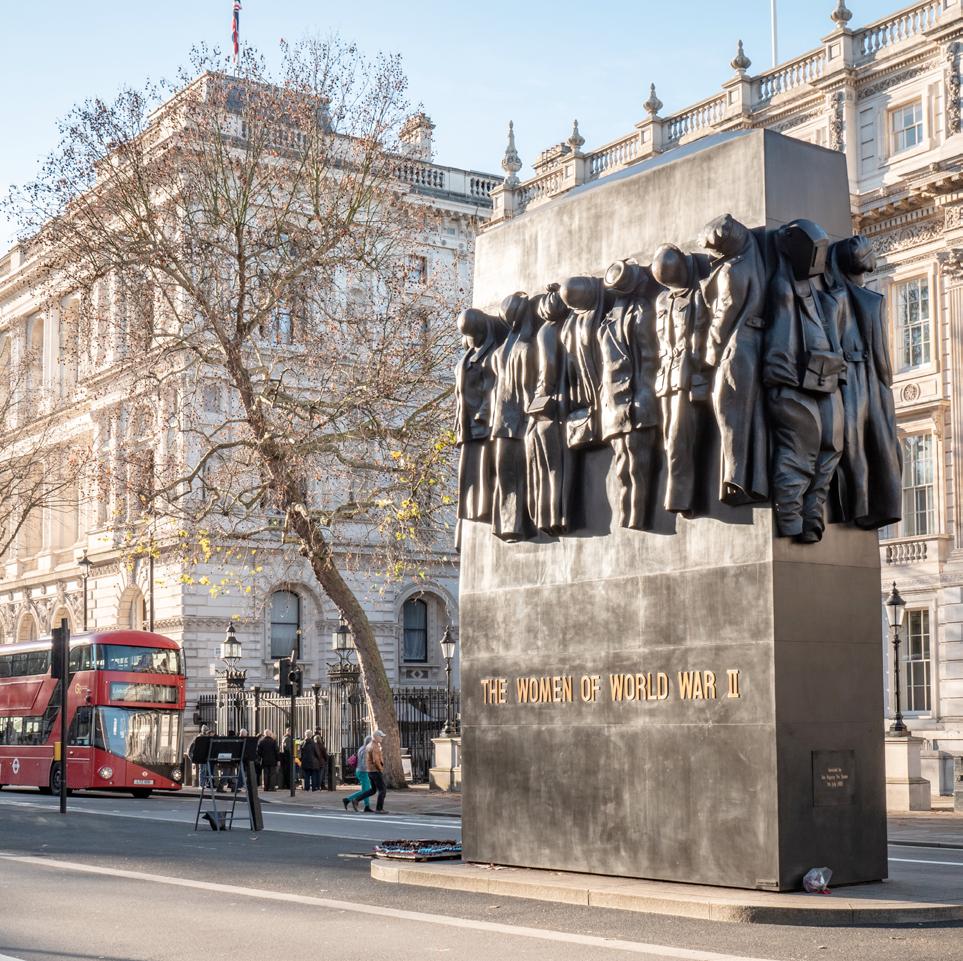
15 The Pyramus & Thisbe Society
Women of World War II monument, Whitehall
fee) and John Anstey was selected.
The necessary preliminary correspondence followed. It was then that our newly selected third surveyor wrote a short (testy) note to say that he had misled himself into believing that our matter was one to which the 1939 Act applied. He was not alone. We had all shared that belief and we were all mistaken. Haringey was not within the boundaries of the old LCC which defined the reach of the Act. It was an embarrassing discovery but all was not lost. The parties consented to Mr. Anstey being appointed arbitrator and on we went.
It was a very rainy day when the ‘tribunal’ met to examine the alleged damage. I arrived early to brief the AO about the visit. At the appointed hour, I opened the front door but found no sign of our arbitrator on the doorstep nor of the BO’s surveyor. I tried again a quarter of an hour later with the same result. After waiting a little longer I decided to venture out into the downpour for a more thorough search. I found them outside the BO’s property without shelter, the rain draining from the brim of Mr. Anstey’s fedora in cascades. Oh dear! It seemed ill-advised to point out that we had agreed to meet at the AO’s house. In spite of this inauspicious start, John Anstey’s award when it came, was scrupulously fair and well-considered and entirely in favour of my appointing owner who promptly invited me to his daughter’s wedding. This was the first but not the last time I was privileged to work with John Anstey. In 1997, the Party Wall etc. Act 1996 came into effect across the whole of England and Wales. With the demise of the GLC in London, it was realised that new legislation was required to preserve the party wall dispute procedures in London and the opportunity was taken to apply them to the country as a whole. The new Act largely mirrored the old one. Some old gaps were plugged but inexpert drafting left us with the troublesome definition of ‘special foundations’ and without a strong enough definition of ‘surveyor’.
Looking back, life under the old regime was very different and becomes increasingly so with the passage of time. The number of practising surveyors was small then and the community well-known to one another. It was suggested to me recently that the reason the new Act’s definition of ‘surveyor’ remained loose was out of concern that there would not be enough qualified surveyors to go round. There were fewer referrals to third surveyors who incidentally, were required to make their award within ten days of a referral being made under s.55(j). Appeals were also less frequent and the 1939 Act contained provisions under ss.55(n) and (o) for appeals to be heard in the High Court instead of the county court at the election of the parties, subject to certain undertakings being given.The 1939 Act gave no authority to the surveyors to settle
a dispute over security for expenses. Under s.57, this was a matter for a judge of the county court.
Awards of that vintage were different in style, often typed on foolscap size paper (with carbon copies) and with fewer reference documents. A full set of construction issue architectural and engineering drawings appended to an award was unheard of. Drawings were usually prepared specific to the subject matter of the award and the party wall would be coloured pink. Ah, the good old days when your office junior could be kept occupied with a set of water colours and a paintbrush! There were no method statements, they having not yet been conceived by health and safety officers. The award itself contained any necessary stipulations about the method of working. Fees were frequently expressed in guineas.
In the background, people in general were more law abiding in attitude and there was greater public awareness of what constituted good behaviour.
The 1996 Act brought immediate changes by extending the rights and obligations established in London, to the rest of England and Wales. Other changes, not least to social outlooks, have been more gradual but no less influential. Today, the circumstances in which surveyors operate under the legislation are quite different. There are many more referrals to third surveyors (who thankfully no longer have to determine the dispute within two weeks) and more appeals to the county court. Lawyers are more involved in the process both before and after awards have been made. They also write most of the authorities on the subject. The public is less instinctively law abiding and less risk averse when weighing up the pros and cons of compliance with laws that carry relatively modest sanction. The practising party wall surveyor now works in an altogether more hostile environment.
Working with the current legislation has brought moments of joy, horror and puzzlement in broadly equal measure. There follow some case summaries where those emotions were enjoyed to the full.
Colebrook Cottage, a home for a time of the essayist Charles Lamb, stands at the end of Duncan Terrace on (a now enclosed section) of the New River, a canal built in 1613 to carry water from Hertfordshire into the centre of London.

It adjoined a development site in Colebrook Row where I was acting for the building owner. The cottage had an enclosed garden with a pond in the centre of which was an island on which stood a life-size bronze crane (Japanese bird, not Scotch derrick). I don’t remember why the garden was so crowded on that cold December day but it was; filled with surveyors, architects, engineers and builders. Stepping back to allow someone to pass, I lost my footing and in the finest
16 The Pyramus & Thisbe Society
John Anstey
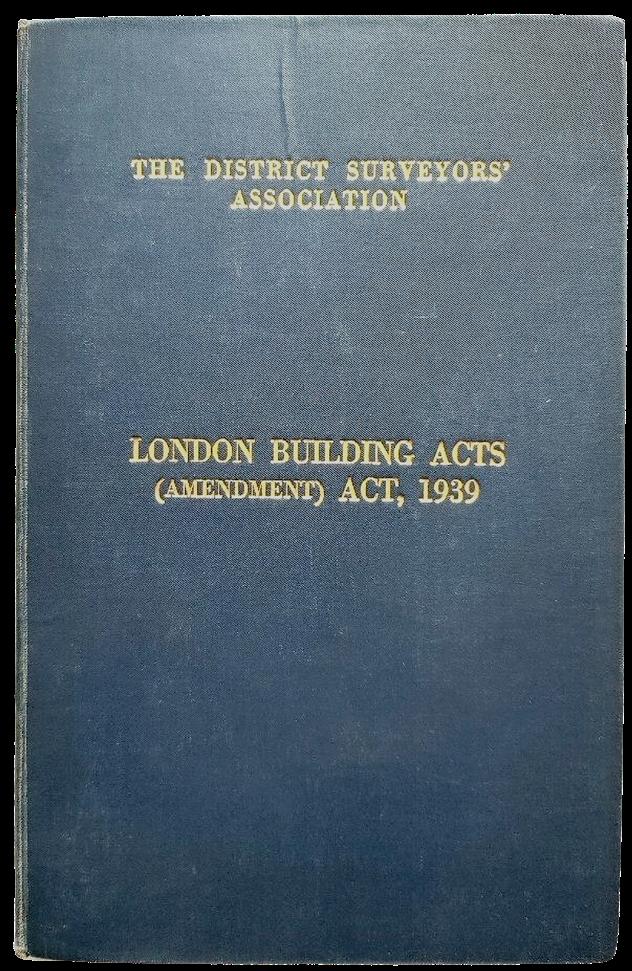
cartoon fashion, fell backwards into the pond. As I surfaced, I heard the concerned housekeeper ask, “Has he damaged the sculpture?”
By contrast, on a very warm day several years later, I met a young surveyor standing in for his principal, the adjoining owner’s surveyor, to prepare a schedule of condition with me. The address in St. John’s Wood was one referred to by the ‘red top’ newspapers as ‘Millionaires’ Row’. The houses were (and are) very large and a bit bling and this was the blingest of all. A Rolls Royce with customised paintwork and trim loitered on the drive. We were ushered in by the housekeeper. We noticed the windows were all open. My companion expressed surprise as the house clearly had air conditioning. It was broken. We suggested it would be prudent nonetheless to close the windows when the demolition began. “What”, asked the housekeeper, “about the mink”. Both surveyors had the same thought, “put it in the wardrobe”. But “no” said the housekeeper making a sweeping gesture with her arm and repeating “the mink, the mink”. It seemed that all of the furniture in the reception rooms, including the sofa on which we sat, was covered in white mink fur.
Jet grouting is a relatively modern construction technique. My first brush with it was a development in Knightsbridge on a constricted site where deep excavations were to be dug to form multiple basements for an ‘iceberg’ building. There were many adjoining properties and no less than thirteen adjoining owners’ surveyors. Happily they all instructed Lawrance Hurst as their advising engineer whose advice proved invaluable to all. There was a debate about whether jet grouting was notifiable work and whether it

would lead inevitably to trespass onto the lands of adjoining owners. I believe we treated it as notifiable being part and parcel of the excavation work, its purpose being to stabilise the ground instead of piling in one form or another which the site conditions made impossible.
The method used was a cementitious form, pumped into the ground under pressure. It went pretty well with only two unhappy moments. An AO’s basement kitchen wall was breached and the grout filled voids beneath his kitchen cupboards necessitating a whole new fitted kitchen. More spectacularly, a titled lady called one day to report a concrete fountain in her garden! She was surprisingly calm and matter of fact about what was likely to have been a unique experience for her, as it was for me.
There are sometimes surprising, unforeseen aspects to a party wall matter. One such was at a very smart house near Hyde Park. It has always been a bad habit of mine to be distracted easily by paintings, sculptures or books during visits to prepare schedules of condition. On this occasion, as I mounted the stairs, I felt more and more strongly that I had seen some of these pictures before. Sure enough there were Picassos, a Piet Mondrian or two and the odd Matisse, among many others. Yes, they were all original works and most of them clung precariously to the party wall. They were insured for an eye-watering sum greater than the GDP of a small country. They could not stay where they were bearing in mind the scale of the neighbour’s proposed works.
A small bookshelf falling off a party wall in Notting Hill recently had created months of correspondence. Can you imagine the fall-out from a Picasso bouncing off a tiled
17 The Pyramus & Thisbe Society
Colebrook Cottage
London Building Acts (Amendment) Act, 1939
Does it involve the removal (excavation) of soil? In my opinion it is notifiable. It is immaterial whether of itself it removes soil from the ground.
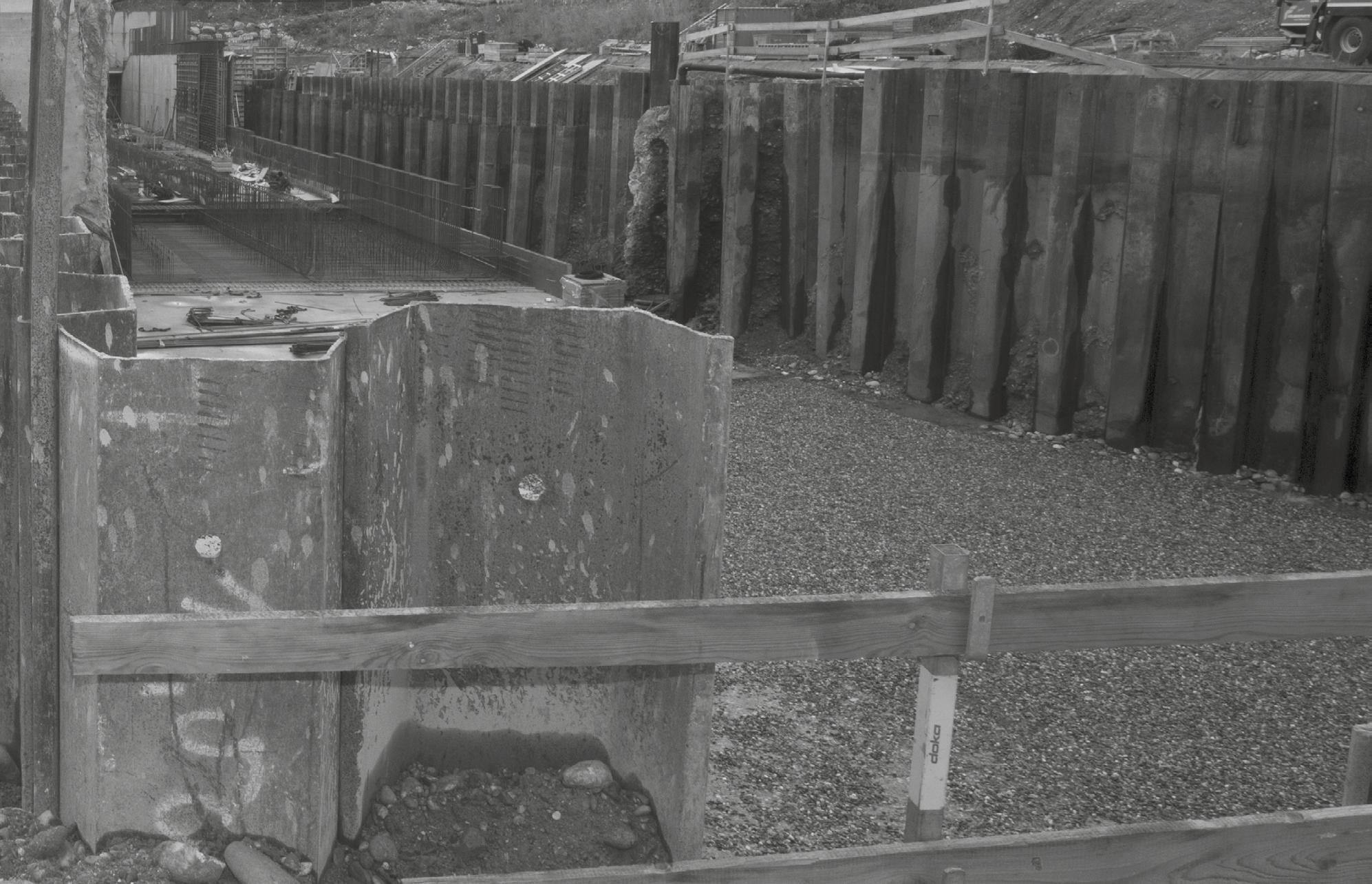
floor at the stair foot three floors below?
It is surprisingly complicated to relocate world heritage class artworks to a place of safety. There are ‘before and after’ condition reports prepared by experts approved by insurers, then specialist removers arrive to pack and crate up. It all takes a lot of time and is hugely expensive. But, so far, so good; until that is the adjoining owner asked innocently what did she have to look at and enjoy while her art collection was away from home? A fair point. We thought of photographic copies, some inexpensive alternative pictures, hiring some paintings from a specialist agency etc.,etc. in the end it was the AO herself who found a perfect nil cost solution. She approached a gallery which exhibited young, up and coming artists and agreed to offer her own house as an extension of the gallery and to invite art-loving friends to view and buy the pictures.
Sheet piling; two words that have the power to wake up the most torpid of party wall surveyors. There has long been discussion over whether this form of construction is notifiable work under the Act. Does it involve the removal (excavation) of soil? In my opinion it is notifiable. It is immaterial whether of itself it removes soil from the ground. It is invariably linked to excavation work and is an essential part of the excavation process where specified. I discovered quite early in my career that bashing this stuff into the ground was a cast-iron guarantee that adjoining properties will be damaged. Alternative insertion methods such as the Giken system are preferable where the pile
sections are pressed into the ground. This however is not without risk.
Several years ago, close by Regent’s Park, I was acting for an adjoining owner who was remodelling his own very large, Grade II listed property. The BO was building two large houses on the adjacent site of one he had demolished. There were multiple basement levels which entailed digging one of the largest holes in the ground I have seen. There was to be sheet piling. My advising engineer, Derek Glenister was very clear. He didn’t like it. He especially didn’t like the jet watering of the pile toe to ease its passage into the ground. Derek explained that in clay soils, the water jetted under pressure risked opening natural fissures in the clay which would cause a rapid expansion in the soil. All of this was explained very patiently to the BO’s project manager, architect, engineer and contractor. It was agreed with the BO’s surveyor and awarded that the water jetting would be omitted; the piles would be pressed into the ground ‘dry’.
One morning, soon after the piling work had started, routine observation of monitoring targets on the AO’s property showed that on one corner, the building had lifted by 20mm. Damage was instantaneous and severe. Of course, the contractor, finding dry insertion difficult, resorted to jetting the pile toe. The predicted fissure in the clay soil opened into a cavity pushing the soil upward with force. It took years and several awards to settle compensation for the damage.
18 The Pyramus & Thisbe Society
While a number of recent decisions in the courts have served to curtail the authority of surveyors, in some quarters it remains beyond question. I was in rather a hurry when I took the call from an adjoining owner, a lady of middle years, residing in one of north-west London’s leafiest and most exclusive suburbs. In fairness, she had suffered much at the hands of two very large developments backing on to her garden.
“They are eating their lunch on my roof. Are they allowed to do that?”
“No C they are not. They are trespassing and you can ask them to leave.”
“Do I have to be polite to them?”
“No.”
Sound of footsteps and window being opened.
“I have my party wall surveyor on the the telephone and he says I can tell you to **** off, so get off my roof!”
My talk for Thames Valley was entitled ‘Anecdotes of a third surveyor’. At some point, I don’t recall when exactly, I began to receive referrals as third surveyor. During the last few months before retirement, I believe I had in the order of twenty cases waiting for my attention. Some were simple, others quite complex and a good number were resolved by informal means.
One of the cases referenced in my talk to Thames Valley branch was an unusual damage claim. The owners lived in substantial adjoining detached houses on a steeply sloping site in Cricklewood. They did not get on. The downhill owner built a 30 metre long extension into the garden on piled foundations. The AO claimed that their garden flooded because the neighbour’s new building dammed surface water that previously drained away. The referrals included some complex legal arguments on trespass, nuisance and easements compiled by lawyers long since instructed by both parties. When in due course there was a lull in the crossfire, I came to consider my award. I decided that I could not give detailed consideration to the legal arguments on extraneous matters. I was not expert in these areas of law and in my view, s.10 of the Act did not require that I should be so. The tribunal formed under s.10 determines a dispute strictly within the confines of the Act. The questions to be considered were therefore;
• Was there loss or damage?
• Was the loss caused by work carried out by the BO?
• Was the work notifiable under the Act.
• Was s.7(2) of the Act in play?
These were the core considerations when making my award which was in favour of the AO’s claim. My award was appealed and as so often happens, I never heard the final outcome.
The immunity of surveyors appointed or selected under
the Act has long been a hot topic. As the discussions swung back and forth, I don’t suppose anyone was thinking about the surveyors suing one another. In 2020 I was selected as third surveyor and unusually, was asked to confirm my willingness to act (and to undertake a conflict of interest check). The case involved minor domestic scale work in north London. In due course, I was asked to make an award by the BO’s surveyor. Immediately afterwards the parties advised that they had settled matters between themselves. No further action was required. However, the BO’s surveyor wanted an award for his fee. I was slow to consider this referral not least because I had doubts whether an award was appropriate. I was served with a notice under s.10(9) to act effectively within ten days. The notice was served on Christmas Eve and my office had closed for the holidays the day before. I did not see the s.10(9) notice until we reopened the office in January by which time the notice period had run. I was no longer the third surveyor.
No amount of explanation, quoting of the Act or reasoned argument succeeded in loosening this man’s grip on his flawed understanding of the rules. His email had been no more than ‘a shot across my bows’. I was still in his mind, the third surveyor. He then threatened to sue me for his fee if I failed to make an award.
In short, that is what he did. He brought a claim in the county court against me for breach of contract. The case was heard in June 2022 and the claim was dismissed. The only surprise in all of this was that any practitioner could imagine that a contract existed between the surveyors. Impartiality, independence?
I ended my talk to Wessex branch with a short quotation, “But be of good cheer…..” words spoken by Hugh Latimer to his friend and fellow Protestant cleric, Nicholas Ridley. Admittedly, their circumstances were even more trying than those of a party wall surveyor managing a difficult owner with a difficult project. Waiting for Queen Mary’s inquisitors to finish piling bundles of twigs at your feet with blazing torches at the ready must have tested their patience even more than an email from one of the profession’s ‘bad boys’ rejecting a request for special foundations consent.
In closing, I send my warmest good wishes to all of my friends and associates in the party wall world and I leave you with some ‘pig Latin’ from my schooldays; nil carborundum illigitimi.

19 The Pyramus & Thisbe Society
davidcharlesmoon@me.com
Letter to the editors
20 The Pyramus & Thisbe Society
Our Ref: AJC/P&T 19 February 2024
Whispers Editorial Team
The Pyramus & Thisbe Society
By email only


One George Yard
London EC3V 9DF 020 7936 3668
info@delvapatmanredler.co.uk www.delvapatmanredler.co.uk
Dear Editorial Team
Is the Party Wall Act optional?
A response to Matthew Hearsum’s article and presentation
We five are writing jointly to express our concerns about aspects and potential implications of Matthew Hearsum’s recent article, ‘Is the Party Wall Act optional?’, published in Estates Gazette (4 November 2023) and his subsequent talks on the subject to P&T members at branch events in London (16 January 2024) and Sussex (6 February 2024).
The sharing of opinions is the lifeblood of the Society, so we appreciate all members who give their time and share their knowledge, particularly in complex areas of legal, surveying or engineering practice that intersect with party wall practice. We are therefore grateful to Matthew for highlighting this area of law, which will impact on surveyors and property owners.
However, we are concerned that Matthew does not make clear various uncertainties in the law or highlight many of the potential pitfalls facing an owner who decides to rely on common law rights rather than comply with the Act’s procedures. We believe this may cause members, and the property owners they advise, to misunderstand the uncertainties and risks, thereby leading to costly disputes. Some property owners, perhaps facilitated by some surveyors, are all too easily attracted to circumventing the Act. We fear the tabloid -style tagline may embolden them, resulting in more widespread disputes among property owners.
We would like to see Matthew address the perceived shortcomings we have highlighted in this email (upon which we expand below) before the Society publishes any article by him in Whispers. We also ask the Society to invite another respected solicitor or barrister to provide a talk or article on the subject as soon as practicable to address these uncertainties and, where appropriate, to rebut some of Matthew’s points. This would ensure members are provided with a fuller and more balanced understanding of the issues.
We understand that a seminar may be in the offing from His Honour Judge Bailey and Victoria Woolf of Osborne Clarke, which we certainly welcome We hope the Society will do what it can to encourage and expedite this and to disseminate a recording or transcript of the event to all members as soon as possible thereafter
The shortcomings
Briefly, the shortcomings we have identified in Matthew’s article and slides include the following:
1. A change in the law
Matthew asserts that Power and another v Shah [2023] EWCA Civ 239 has changed the law and developers can now build on or excavate their land or undertake certain types of work on party walls without following the Act. We believe that to be incorrect for two reasons.
Also at:
Delva Patman Redler
The Quay
12 Princes Parade
Delva Patman Redler
40 Berkeley Square
Bristol
Liverpool L3 1BG BS8 1HP
Delva Patman Redler LLP. Registered in England & Wales OC335699. A list of members can be inspected at our Registered Office above.


21 The Pyramus & Thisbe Society
19 February 2024


First, the remarks by Lewison LJ at paragraphs 73 and 102 of his supporting judgment were obiter dictum and therefore lack the force of precedent. Secondly, Lewison LJ is only repeating what other judges have said previously. For example:
• In Louis v Sadiq [1997] in the Court of Appeal, Evans LJ said, “The adjoining owner’s common law rights are supplanted when the statute is invoked”
• In Kaye v Lawrence [2010] in the High Court, Ramsey J said [paragraph 59]: “when the provisions of the relevant Act are operated, the common law rights are “supplanted” or “substituted” by the rights under the Act in relation to matters dealt with under the Act”; and [paragraph 62] “the building owner is exercising rights under the 1996 Act when he acts as such”
• In Group One Investments Ltd v Keane [2018] in the Court of Appeal, Hickinbottom LJ said [paragraph 2]: “the purpose of the 1996 Act being to provide a simple and relatively inexpensive statutory dispute resolution mechanism, which, when the provisions of the Act are operated, supplants the respectiv e common law rights and replaces them with rights under the Act… If for any reason the statutory procedure is not followed, then the parties’ respective common law rights and obligations continue to apply.”
Matthew may be correct that common law rights are only supplanted by the rights under the Act once notice has been served – which hopefully can be clarified soon – but this cannot be said to be new law.
2. Obligation to serve notice
Even if a property owner is exercising their common law rights to undertake work, if they are proposing to carry out work of a type listed in sections 1, 2 or 6 of the Act, the Act says they “shall” serve notice on any adjoining owner.
Matthew does not explain how a property owner may lawfully circumvent the requirement to s erve notice. His slides suggest it is because a developer who is not exercising rights under the 1996 Act, but rights at common law, is not a ‘building owner’ and the obligations do not apply. But in Heathcote v Doal [2017] in Birmingham County Court, the judge awarded an injunction and costs against a property owner who was excavating their own land without a valid notice.
We are therefore concerned Matthew’s conclusion that “developers may therefore choose to undertake the excavations under their common law rights, or to use the procedure in the 1996 Act” could be incorrect and may put members at risk of giving potentially negligent advice.
3. Breach of statutory duty
The flip side of the previous point is whether the failure to serve notice under the Act of an intention to carry out work of a type listed in sections 1, 2 or 6 of the Act constitutes a breach of statutory duty and whether an adjoining owner has a remedy in damages. The case law on this does not seem clear. (See Crowley v Rushmoor Borough Council [2010] EWHC 2237 (TCC) and Hough v Annear (2007) 119 Con LR 57.)
We feel Matthew should have highlighted this uncertainty, so that members know to make owners who seek to rely on common law rights aware of this.
4. Other potential pitfalls
Matthew’s slides give two reasons for using the common law and five reasons for u sing the Act. They do not, and nor does his article, set out clearly any of other the potential pitfalls of relying on common law rights alone We believe they are extensive, including:
• Developer would be at greater risk of claims for nuisance, negligence, trespass, and wrongful interference of an easement or right.
• Lack of a surveyor tribunal would probably result in the lack of an agreed methodology for the works or schedule of condition. Consequently, the burden of proof as to causation of any damage would most likely fall on the developer rather than the adjoining owner. (Roadrunner Properties Limited v Dean [2003] EWCA Civ 1816)
Page 2 of 3
22 The Pyramus & Thisbe Society
19 February 2024


• An award of common law damages against the developer for any resulting nuisance or trespass could include consequential losses in addition to direct losses. In Louis v Sadiq [1997], because of the delay to the adjoining owner of being able to sell their property due to damage and the lack of an award, the awarded damages included four years’ mortgage interest, extra building costs for their new house in Guadeloupe due to increased prices (which the court held were reasonably foreseeable and not too remote), and general damages.
• Possible invalidity of insurance policies and/or difficulty with funders for failing to comply with statutory requirements.
Conclusion
We believe this could become a contentious area for property owners and surveyors. Whilst it is right that Matthew Hearsum highlights this, we feel members should be made more aware of the counterarguments and potential pitfalls, so they are better equipped to advise property owners.
We hope Matthew will provide further clarity in due course; however, we ask the Society in the meantime to invite another learned member from the legal profession to share their opinions on the subject and address the points we have highlighted
Yours sincerely
Aidan Cosgrave, Ashley Patience, Rob French, Shirley Waldron and Conor Healy
Page 3 of 3
23 The Pyramus & Thisbe Society

M ATTHEW HEARSUM ADDRESSES the impact of the recent Court of Appeal decision in Power and another v Shah, which challenges the consensus view on the availability of common law rights
24 The Pyramus & Thisbe Society
Is the Party Wall etc Act 1996 optional?
THE PREVIOUS CONSENSUS AMONG practitioners was that the rights and responsibilities set out in the Party Wall etc Act 1996 repealed and replaced the parties’ rights at common law. A developer who wanted to undertake works of a type listed in sections 1, 2 or 6 of the 1996 Act had to serve a notice under the relevant section and obtain either the adjoining owner’s consent to the works, or an award from a tribunal of surveyors.
A change in the law
In May 2023 the Court of Appeal handed down judgment in Power and another v Shah [2023] EWCA Civ 239. This decision principally concerned whether owners of adjoining land could rely on the dispute resolution provisions in section 10 of the 1996 Act if a building owner commenced works of the types listed in the Act without serving the relevant notice. The court held that the adjoining owner’s rights under the 1996 Act only arise after the building owner has served a notice. Unless and until a notice is served, adjoining owners have no rights under the 1996 Act, but may still bring claims in trespass or private nuisance. This principle is summarised in the slogan: “No notice, no Act.”
However, many are unaware that the decision in Power goes further; and developers also continue to enjoy all their rights at common law, including the right to undertake certain types of work listed in the 1996 Act without following its procedures.
This is at odds with the previous consensus among both surveying and legal professionals that the statutory rights in the 1996 Act operated as a wholesale replacement of the building owner’s rights at common law.
In the words of Lord Justice Lewison in Power: “So they
do, but only once the Act has been brought into operation.”
Until then, developers remain free to exercise their common law rights. Lewison explained that “it is the service of the party structure notice that causes the substitution of rights under the Act for common law rights”.
Works to an existing party structure
The rights to undertake works to an existing party structure at common law depend on what type of party structure it is. A detailed analysis of all the diverse types of party structures is beyond the scope of this article.
Broadly speaking, the two most common types of party structure are:
A structure divided into two moieties, each belonging to the adjoining property, but with right or user and support over the other moiety; and
A structure which belongs wholly to one owner but is subject to a right in favour of an adjoining owner to use the structure as a division between two buildings (or parts of buildings) on different land.
For type (a) party structures, at common law each owner may do what they like with their moiety, provided (1) they take reasonable care and (2) do not interfere with the easements of user and support in favour of the other moiety. This would include, for example, undertaking repairs to the party structure, or cutting into their moiety up to, but not across, the boundary line to insert a steel beam on a padstone or spreader plate.
For type (b) party walls, the owner of the wall may do as they please with their structure, provided they take reasonable care and do not infringe the other owner’s right to use the structure as a division between two buildings or parts of buildings.
25 The Pyramus & Thisbe Society

Adjacent excavations
At common law, the starting point is that an owner of land may do as they wish with their land, including excavations within three or six metres of the boundary line, irrespective of the depth of those excavations, provided they do not interfere with any rights of support or cause damage to neighbouring land.
Developers may therefore choose to undertake the excavations under their common law rights, or to use the procedure in the 1996 Act.
Construction at or near the boundary
As with adjacent excavations, at common law an owner of land may (almost) do as they wish with their land. This includes the construction of a wall at or near the boundary with adjoining land.
However, unlike the statutory right in section 1 of the 1996 Act, the common law does not permit the projection of foundations beneath adjoining land. Nor are there rights of access to adjoining land similar to section 8 of the 1996 Act, or indeed at all, and so the building owner would face significant difficulties in pointing or rendering the new wall.
Conclusion
The complex interrelation of rights and responsibilities that building and adjoining owners enjoy at common law explains the need for the 1996 Act and its predecessors,
which provide a speedy and (mostly) cost-effective means of resolving disputes compared to legal proceedings.
The 1996 Act also includes rights that do not exist at common law – for example, the right to underpin a party structure in section 2(2)(a) of the 1996 Act – or rights that are more expansive than those at common law, such as the right to demolish and rebuild a party wall to a greater height under section 2(2)(e).
Where a developer has a choice to proceed under the 1996 Act or under their common law rights, taking specialist legal advice on their options would be a sound investment.

Matthew Hearsum is a partner in the property litigation team at JMW Solicitors
Previously published in the Estates Gazette on 4 November 2023
26 The Pyramus & Thisbe Society
matthew.hearsum@jmw.co.uk

The Right to reply
Dear Editors,
The purpose of my article in the Estates Gazette (“EG”) was to provoke a debate about an aspect of the Power decision that I felt had been overlooked. That endeavour appears to have been successful.
However, the EG article is not a complete account. It was, by editorial necessity, limited to the points that could be expressed within the limit of the 750 words kindly made available to me in that edition of the EG. It would likely require around 3,000 or 4,000 words to address the issue fully, and answer some of the questions raised by others. If there is appetite among the readers for such an article, I would be willing to prepare it for the next edition.
Regards,
Matthew Hearsum
27 The Pyramus & Thisbe Society
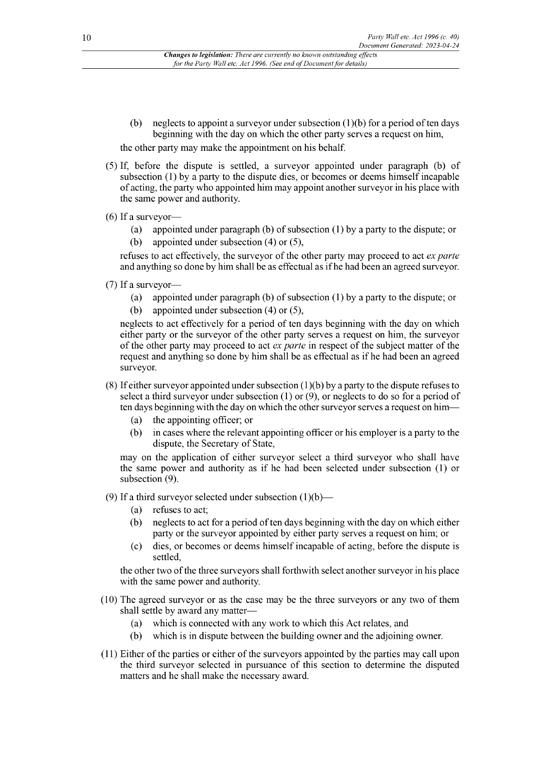
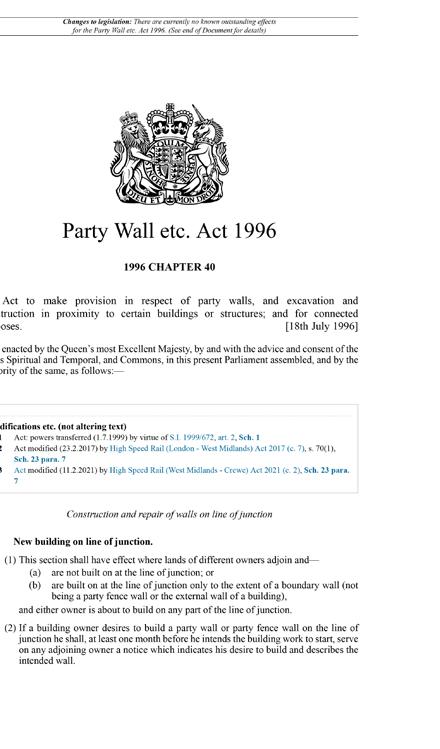
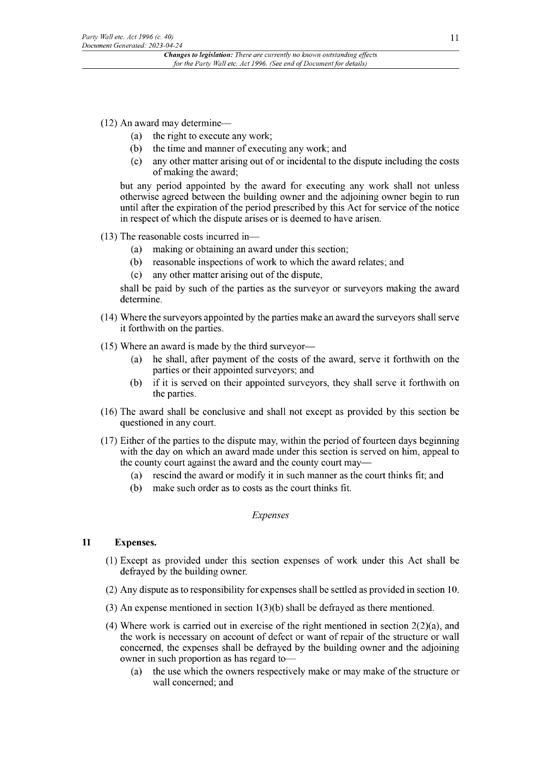
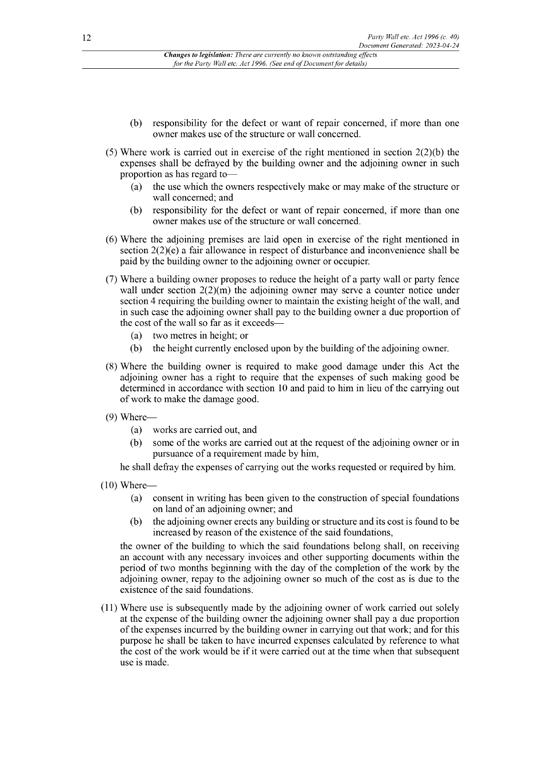
Is the Party Wall etc Act 1996 optional? The Society’s View
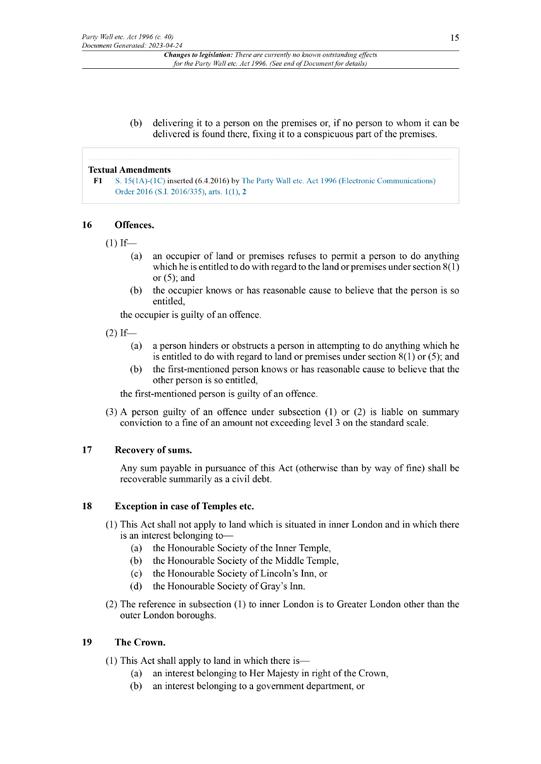
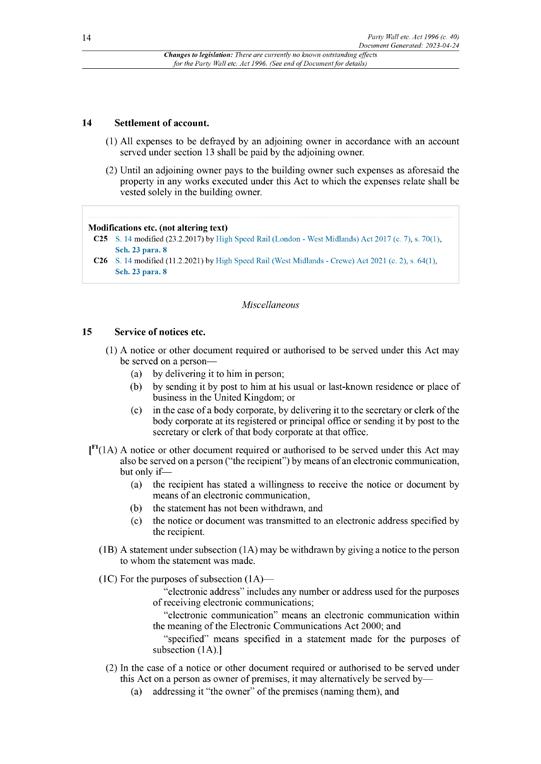
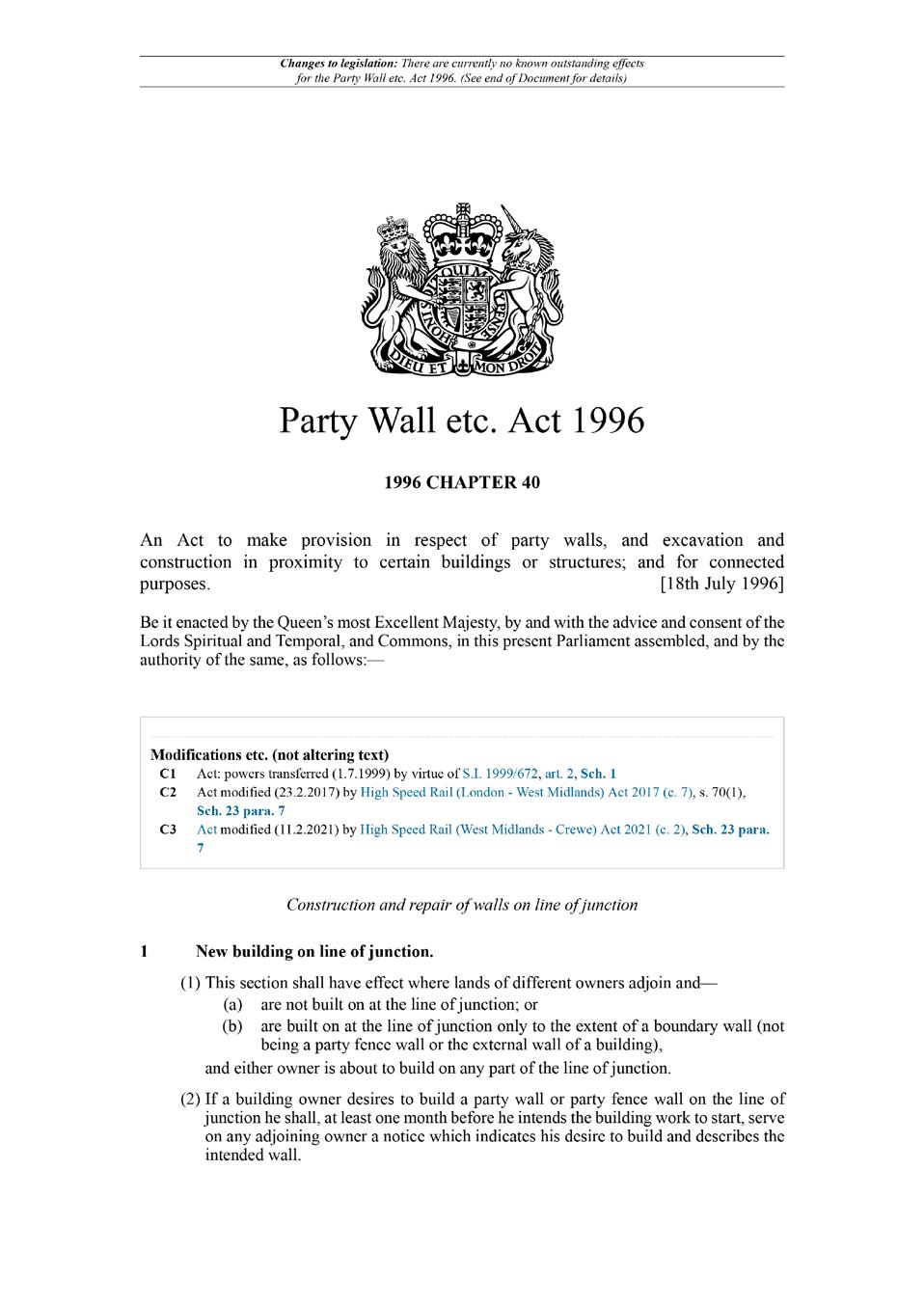

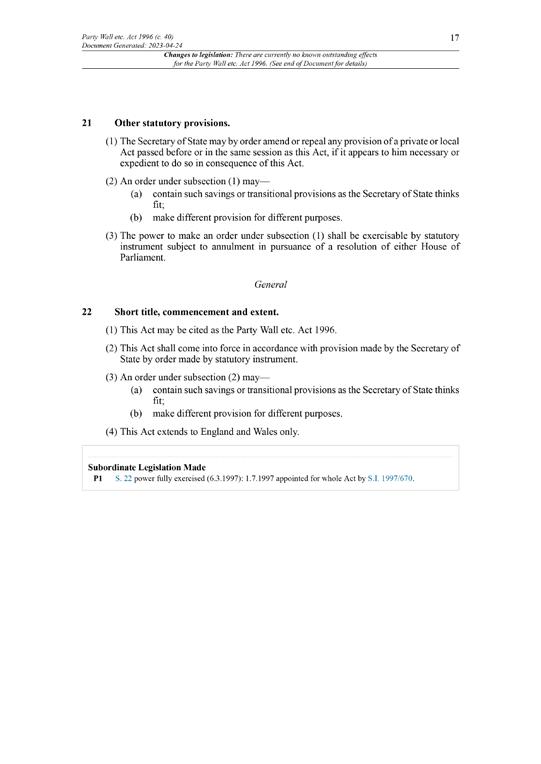

IMatthew Hearsum appears under the headline ‘Is the Party Wall etc. Act Optional?’. Originally published in The Estates Gazette, it is reproduced by permission of the author and original publisher. The views expressed in that article do not accord with those of the Society. In what follows, past and present members of the Society’s Management Board set out their answers to
The Publications Officer’s View
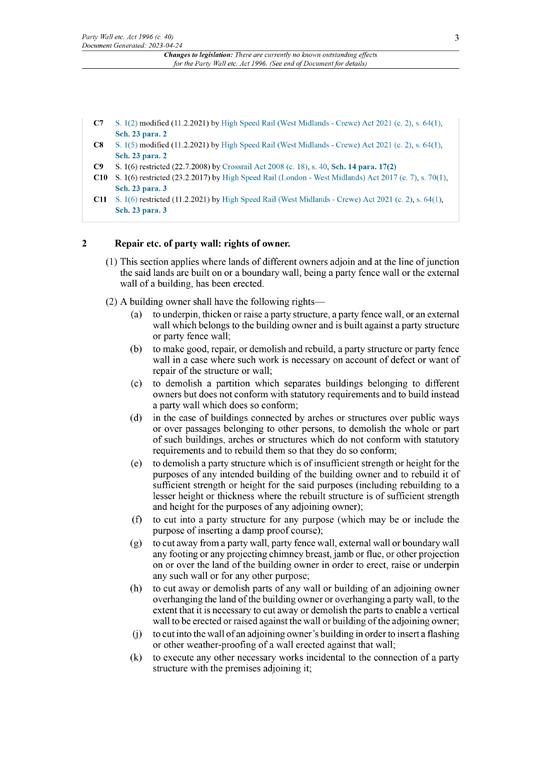
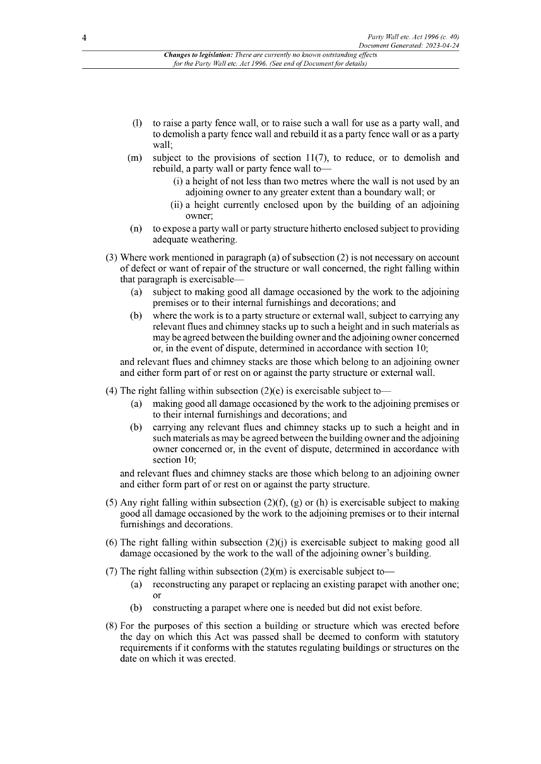
As the Society’s newsletter, Whispers has always accommodated a broad range of opinion among members. Debate is encouraged, always with the object of informing the readership and offering a platform for views to be expressed freely. It is in this spirit we asked for permission to reprint Mr. Hearsum’s EG article. In the same spirit, we encourage the
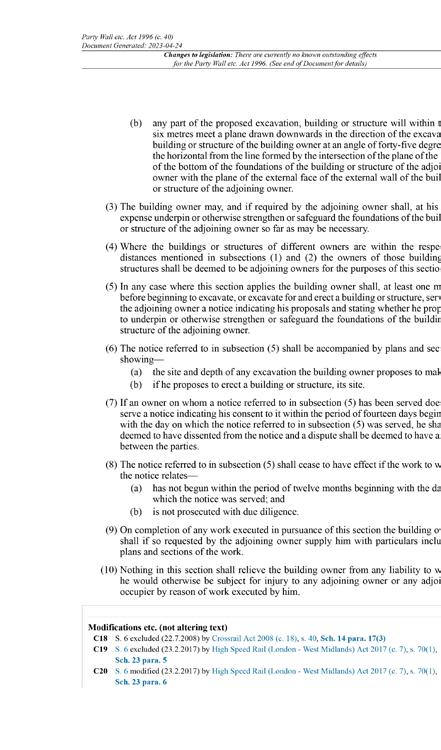
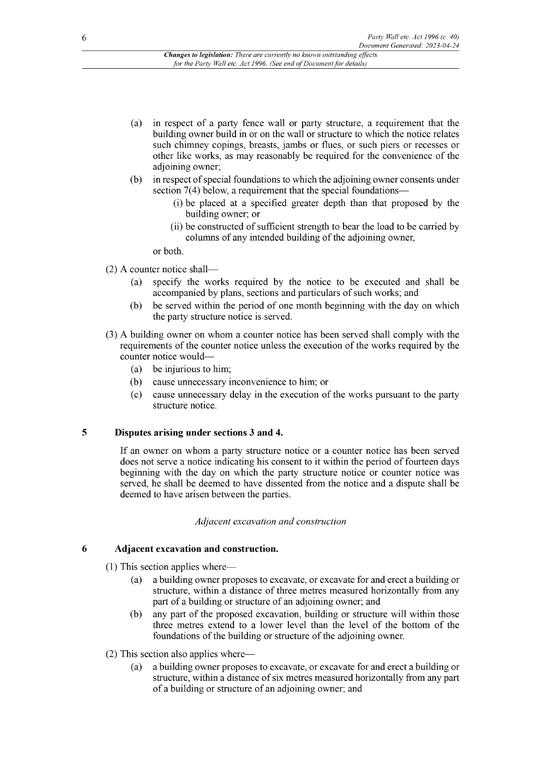
expression of contrary opinion. In this case, the central issue is one of the first importance to the profession. Unsurprisingly, there has been strong reaction to a proposition that the Act may be treated as an ‘opt in or opt out’ set of protocols. The Management Board believes it is important to state the position of the Society unequivocally. The collected views of the board members set out here, to which I add my full support, should offer reassurance to our membership that the Act is mandatory and owners must be advised accordingly.
The immediate past Honorary Secretary’s view
ANDREW SCHOFIELD

I think that Mr Hearsum has overlooked an important bit of the Act which is that the service of notices prior to the exercise of rights conferred by the Act is mandatory (see s1(2) and (5), 3(1) and 6(5)) “…..SHALL serve notice on any …..”.
28 The Pyramus & Thisbe Society
Therefore, it follows that if a building owner doesn’t serve notice he is in breach of his statutory duty. That is why, if forced to apply for an injunction, the adjoining owner’s witness statement need only say that he believes that the works being undertaken fall within the rights conferred by the Act and that notice in respect of them has not been received. The important thing about this case is that it has confirmed the view held by most practitioners that if a building owner decides to ignore the legislation, he cannot rely on it later on.
The problem is not the Act, it is the law because the only form of enforcement by an adjoining owner is injunction which comes at a price and risk, albeit in my experience this is often exaggerated by lawyers and can be all but eliminated by careful adherence to the process. For most people, their property is a valuable asset and from time-totime steps have to be taken to protect it. These can range from painting and repairing the gutters to stopping a neighbour from doing something that might damage it. If they are not prepared to do this then why are they dissenting from works described in a notice? I’ll tell you why, because they are told by most surveyors (serving selfinterest) that they don’t have to pay for it.
I’m not for a minute saying that the Act wouldn’t benefit from more teeth but if it is given them, it must come at the cost of higher standards amongst practitioners and substantial improvements in the judicial system of enforcement.
The Education Officer’s View
STUART BIRRELL

I would add that it is always an option to ignore the law, for instance you can speed in your car providing you are prepared to accept the risk of points on your licence and a fine! Of course, with the no notice, no act ruling to not issue notice would automatically put the situation back into the common law. This would only give very limited rights to carry out works to a Party Wall, limited to repair of their own side of the wall and limited cutting in. All other conferred rights contained in the PWeA 1996 would not be available. The BO would have to accept the potential far reaching consequences. Whilst the Act doesn’t have teeth, Common Law certainly does.
The immediate past Membership Officer Relays a Point of View
DEREK
BATE

I recall Stuart Frame putting the suggestion forward (I used the word suggestion not opinion purposely) in a CPD meeting, that a BO might give notice if he was desirous of undertaking pursuant work and taking advantage of the
benefits of the Act (such as access). In other words, there was no penalty for not giving notice and continuing with pursuant works and so, if there’s no benefit, why bother.
The immediate past Treasurer’s View GRAHAM NORTH

I do not agree with Matthew Hearsum’s view. It seems to me that what he is suggesting is that a developer can either choose to follow the Act or not if he is exercising his common law rights. So, for example if he wants to dig a big hole on his land even if that big hole is within 3 or 6 metres of next door etc., he can choose to either serve Notice or not.
That cannot be correct.
The Chairman’s View FAREED F FETTO

The comments above remind me of the time when I was a student, visiting my aunt in Sheffield in my Mini -a real one! The very last leg of my journey presented me with a choice: bear left or right?
It caught me every time, so I was quite relieved to see two burly officers and their motorcycles at the junction. I stopped and asked them for directions. Having given them, the officer placed his hands on his hips, saying: “And don’t break the speed limit!”.
“Don’t break the speed limit” implies a choice, does it not?
Having a choice does not liberate me from the law, nor does it change the law.
No, my choices are ‘law-abiding’ or ‘outlaw’. Each choice has consequences.
Anyone who has driven in Beirut and survived deserves a five-star credit on their licence! And a mention in the Guinness book of records. And their name on the King’s honour list!
On one occasion, my father, followed a local car thereby inadvertently driving up a one-way street. Both he and the local driver were stopped by the police. My father explained that he was a stranger and that he simply followed the local driver without noticing that it was a one-way street.
The police fined the local driver, once for their misdemeanour and twice for my father’s!
Our Society is dedicated to the proper and lawful application of the Act, and to encourage others (including –especially- building owners) to do so.
While we welcome any contrary point of view, I hope you will agree that we, as a Learned Society must set and maintain the highest standard of best practice, by example, by good leadership and by the propagation of good advice. The alternative is unthinkable.
29 The Pyramus & Thisbe Society
“Is the Party Wall Act reall y optional?” Talk Given by: Edward Bailey, Howard Smith and Victoria Woolf Save the date 05.06.24
Where ___The Little Ship Club, Bell Wharf Lane, Upper Thames Street, London EC4R 3TB When ___ 6:00pm on 05.06.24
Dealing with the bloody-minded building owner; party structure notices, and going to court
His Honour Edward Bailey

Introduction
My first pupil-master, an Oxonian Scot, was a treasure trove of esoteric information. He took a great interest in his pupils, in part, I always suspected, because he was usually on the lookout for a challenge other than the next set of papers. He set himself both the daily task of teaching me something new about the law, and the daily challenge of finding some fact or matter outside the law of which I had thitherto being ignorant. This challenge was rarely difficult, and its success was met, invariably, with the recitation of the maxim “It’s wonderful how knowledge doesn’t spread”.
Wonderful or otherwise, we all learn, repeatedly, that knowledge about the law relating to Party Walls is spread mighty thin, if indeed it can be said to be spread at all. This is hardly surprising. A secondary school curriculum that included even a basic introduction to party wall law would engender suspicion, for the remainder of such a curriculum would be strange indeed. And the brightest student can obtain a bachelor’s degree in law, a post-graduate degree in law, and a professional qualification, even with enviable honours, without this little legal backwater crossing his (or her) horizon.
Personally, I had spent some four or five years in practice at the Bar before I encountered the intriguingly entitled
London Building Acts (Amendment) Act 1939. I approached it from the construction rather than the chancery side of things, and found to my considerable gratitude, in a set of chambers that aimed for the soubriquet ‘commercial’ more than anything else, that any instructions relating to the 1939 Act were usually sent in my direction. In those dark days, the county court, with a civil jurisdiction limit which in my time rose from £400 to £1,200 and then to the staggering heights of £4,000, was generally thought to be beneath contempt. Certainly no interest was ever shown in the decisions of its judges, and so the (to my mind at least) brilliant contributions I offered to the jurisprudence of this little legal backwater by way of insightful submissions found their way into judgments to which no-one paid the slightest interest.
Accordingly when, nearly 30 years later, I found myself sitting in the TCC list of the Central London County Court (jurisdiction in civil matters now unlimited!) with yet another application for an interim injunction to restrain the continuation of building work in breach of the provisions of the Party Wall etc Act 1996, I was generally sympathetic to the building owner who told me that on commencing his works to a party wall he had been completely unaware of the existence, let alone the provisions, of the 1996 Act. Even where the building owner had had to obtain planning
31 The Pyramus & Thisbe Society
permission, the fact that the 1996 Act would plainly apply to the permitted works, plain even to a half-competent council planning officer, was apparently not drawn to the attention of the successful applicant. The 1996 Act was one of those pieces of knowledge that, wonderful to relate, did not spread.
But among the many ignoramuses are the b*st*rds to whom knowledge of the Act has indeed spread, and that knowledge came as most unwelcome news. They know that notices should be served, that party wall surveyors are likely then to become involved, and that, worst of all, the building owner usually ends up paying the fees of both his own and the adjoining owners’ surveyors. Relying on the average citizen’s great reluctance to go to law, (courts being frightening places and lawyers expensive beyond all imagining), these building owners charge straight in and aim to complete their party wall works before any court can usefully prevent them. A reassuring word to the neighbour that everything will be done to ensure that the works are completed as quickly as possible, (you bet!), and a few kindly words to the effect that there will be no noisy weekend working, and there was a reasonable prospect of getting out of statutory compliance, at least until it is too late for the AO to obtain such benefits as are available to him under the Act.
My attitude to such so-and-sos, once I was confident that they had been correctly identified, could be summed up in two words: “indemnity costs”. However I have learnt recently (to my concern) that this attitude may have been one of the (many?) ways in which I was out of step with at least some of my brethren on the bench.
So how should the adjoining owner and his surveyor approach the situation created by the bloody-minded building owner (“the BMBO”)?
Might there have been a notice?
The first and fundamental point to remember is ‘no notice, no Act’. The BMBO will not have served a notice, at least not a formal notice, because he wants to evade the application of the Act. But it may be that he has engaged in pre-works correspondence, perhaps because he is apprehensive that if the first thing the AO knows about his works is loud noises affecting the party wall he may be more likely to be stirred into action than if he has been gently warned about the works in advance. The assiduous party wall surveyor assisting the exasperated adjoining owner (“the EAO”) will ask to see any letters or other documentation that may have passed between the neighbours in the weeks and months before the works commenced.
Any pre-works documentation should be considered carefully. Unwittingly the BMBO may have provided one or more documents sufficient to constitute a notice. But what constitutes a Notice? Plainly a Party Structure Notice must be a document because it is required to be served. There is however no statutory necessity for a document constituting a party structure notice to state in terms that it is such a notice or, indeed, contain the word ‘notice’.
What the party wall surveyor must be careful to avoid, in any circumstances, is leaving the strict confines of the Act and seeking to generate a Notice by asserting that, eg, letters or notification documents which may refer to proposed works but are not obviously intended to be notices served under the Act do in fact constitute a Notice which justifies the appointment of party wall surveyors and, ultimately, the making of an Award.
There are three statutory requirements for a party structure notice under s.3(1), namely (a) the name and address of the building owner, (b) the nature and particulars of the proposed work, and (c) the date on which the proposed work will begin. All three requirements must be met before there is a valid statutory notice, although it is perfectly possible for a document to constitute a valid notice which does not within itself meet all three requirements provided it refers to other documents which, taken together with the first document, meet the statutory requirements. The prime example is the party structure notice which refers to plans, sections, and other drawings which provide the particulars of the proposed works. Indeed, where special foundations are proposed, s.3(1)(b) makes it plain that such additional documents are expected to accompany the notice document. A party structure notice, incidentally, does not have to be signed unless its terms make a signature imperative.
Requirement (a) is clear enough. A document which comprises an effective party structure notice must have the BO’s name and address.
Requirement (b), “the nature and particulars of the proposed work” is more open to interpretation. The ‘nature’ of the work may be simply stated and, eg, “loft extension” or “removal of chimney breasts” or “repairs” or “heightening the parapet wall” will be sufficient. But ‘particulars’ of the proposed work can be more problematic. In a substantial majority of cases, where the BO is behaving responsibility, the BO will have available plans, specifications and drawings prepared for planning and building regulation consents and construction, and copies of these documents can be attached to the party structure notice and thus provide the AO with a wealth of particulars of the proposed work. But in the present context the party wall surveyor is looking to see whether documentation provided by a BMBO does in fact comprise a party structure notice when no such notice was intended and any particulars of the proposed work are likely to be thin on the ground.
What is required to provide sufficient particulars for the purposes of s.3? This question fell for consideration in the case of Hobbs, Hart & Co v Grover [1898] 1 Ch 11 where the provision in question, s.90(1) of the London Building Act 1894, was in the same terms as s.3(1) 1996 Act. Hobbs, Hart & Co was rather an extreme case. The BOs had purchased no 75 Cheapside intending to pull the building down and rebuild it without being certain whether the party wall with no 76 Cheapside needed itself to be rebuilt. The party
32 The Pyramus & Thisbe Society
structure notice served on the AO simply set out almost the entirety of s.88 of the 1894 Act; as if today a party structure notice recited the entirety of s.2(2) as the proposed works to be carried out. It is perhaps a comment on the approach adopted by the profession at the time that counsel for the BOs were able to argue that this was the form of notice regularly used by “London architects”. The BO’s argument was that they could not give a notice in detail before they knew the precise condition of the wall, and that would not be known until it had been exposed by pulling down the remainder of the property.
This argument found favour with Channell J. who accepted that the detail of the necessary works might not be known for many months, and he upheld the notice on the BO’s undertaking not to act on that part of the notice which covered the raising of the party wall without first giving the AO inspection of his plans and a further period of ten day in which to appoint a surveyor. This did not wash before a strong Court of Appeal. The law report records Chitty LJ asking “Should not the notice be such as will enable the adjoining owner to judge whether he shall consent or object to the proposed works?” and Vaughan Williams LJ asking “Ought not the notice to give such particulars of the proposed works as will enable the adjoining owner to judge whether it will be necessary to pull down the old wall?”. In the chair was Lindley MR who asked “How can the notice be sufficient unless it enables the adjoining owner to see what counter-notice he should give under s.89?”, this section being the forerunner of s.4. In the event all three members of the Court of Appeal concurred in the judgment of the Master of the Rolls: “In my opinion the notice ought to be so clear and intelligible that the adjoining owner may be able to see what counter-notice he should give to the building owner under s.89. This is the key to the whole matter.” (Judgments were often short and to the point back then!).
Whether the Court of Appeal today will feel bound by the comment that the ability to serve a counter-notice is “the key to the whole matter”, may be doubted. It can be discounted as simply a comment relating to the particular appeal before the court. However, a consideration of s.4(1) does suggest a fair amount of detail is required to give the required “particulars” for otherwise how will the AO know whether to require “chimney copings, breasts, jambs or flues , piers or recesses or other like works” in his counternotice? On the other hand, were the nature of the works to be such that there would be no question of a counter-notice requiring chimney copings, breasts, jambs etc etc ever being served, is it arguable that the necessary particulars can in practice be very thin?
In my view not, and the questions posed by the other two members of the Court of Appeal (set out above) become pertinent. If a reasonable AO is unable to make an informed decision whether or not to consent to the proposed works on the basis of the particulars provided, a party structure notice
will have failed to fulfil its statutory purpose. The fact that most AOs will (sensibly) not agree to the works and will expect party wall surveyors to be appointed is nothing to the point.
Requirement (c) (“the date on which the proposed work will begin”) is, on the face of it, very clear; a date is required. In practice a date is rarely given, presumably because no BO can be confident when his builders will actually start, although as long as the date provided is at least two months after the date of service of the notice it is difficult to see how any objection can be taken if the date is missed. What happens in practice? Of the two leading textbooks in this area one (very sensibly) avoids offering precedents. The other, perhaps because of its multiplicity of authors, does offer precedents and suggests “I propose to begin work after the expiration of two months from the date this notice is served on you, or earlier if you agree”. The RICS suggested party structure notice is in very similar terms: “… it is intended to carry out the works detailed below after the expiration of two months from the service of this notice, or earlier by agreement”. Other templates offered on line are also in similar terms. Only the gov.uk website template specifies the insertion of a particular date, and then subject to a note which states the “If you do not know exactly when your works will start you may wish to add ‘or thereafter’”.
Is the standard party structure notice defective for want of a date? Arguably yes. The Act requires “the date” not “the date not before which” or “the date after which”, and it is hardly difficult to specify a date, even though it may be difficult to keep to it once specified. From the AOs’ point of view it is of interest to know when the works will commence, and the standard form template merely gives him a tenmonth window (the notice does of course lapse if the works are not commenced within twelve months of service) during which the works might start. On the other hand life for the BO could become impossible if his party structure notice could be challenged on the basis that the date given had come and gone without the works starting. I would not expect a court to strike down a party structure notice which did not strictly meet the requirements of the Act, although framing the judgment might not be straightforward. Further comment would be tedious.
The upshot of the above is that it will be a rare case where the BMBO has provided sufficient particulars of his works in documentary form, and also complied with the other requirements for a party structure notice to enable a party wall surveyor to find such a notice on any pre-works documents sent by the BMBO to his neighbour. It is important that a party wall surveyor, seeking to help the EAO in the face of a determined BMBO, does not to take things too far in an effort to bring the scheme of the Act into play. He runs the risk that the BMBO will simply ignore the subsequent Award and the work put into the Award will be wasted because the court will find that there was no notice.
33 The Pyramus & Thisbe Society
No party structure notice served
Somehow the BMBO has to be persuaded to serve a party structure notice, something he will presumably be most reluctant to do. What if he simply refuses, and ignores threats of proceedings, as to which see paragraph 22 below? With more than a little ingenuity it might be possible for the AO to turn himself into a building owner. For example, the owner concerned could himself serve a party structure notice relying on s.2(2)(b), for any work carried out by the BMBO without express agreement from the AO or under the authority of an award will constitute damage to the party structure which will then require ‘repair’. This party structure notice could be served together with a letter pointing out that s.8 of the Act enables a building owner and his workmen ‘to enter and remain on any land or premises for the purpose of executing any work in pursuance of this Act’, and stating that in order to repair the party wall such alterations as the BMBO has carried out without agreement or statutory authority will have to be undone and the party wall returned to its original condition. This approach should certainly set the cat among the pigeons! Indeed the situation might be inflamed even further by stressing in the letter accompanying the party structure notice that after the party wall has been repaired by returning it to its original condition the BMBO, as adjoining owner, will be making use of the building owner’s work. Accordingly under s.11(11) of the Act the BMBO will become liable to pay a due proportion of the expenses incurred by the building owner in carrying out that work, the due proportion being the entirety of the expenses!
I would not however myself advise an EAO, however infuriated by the BMBO, to follow this course and serve his own party structure notice, although that is not a reason not at least to threaten the service of a notice. It is fraught with difficulty, and who knows how the High Court or county court judge before whom the matter eventually comes will react. (He/she may have no sense of humour.) An AO is best advised to remain an AO and to proceed accordingly. Where neither cajoling or threats succeed, ‘proceeding accordingly’ means seeking an interim injunction in the county court, or, if so advised, the High Court. This should not be as scary as many surveyors and owners believe, but has to be approached in a sensible and careful manner. As to what constitutes a ‘sensible and careful manner’ I comment on below.
The BMBO must be threatened with injunction proceedings, and this threat should be contained in or accompanied by a letter stating in terms that the BMBO’s blatant disregard of the 1996 Act is a matter which warrants an immediate order for indemnity costs in the event that the BMBO refuses to desist from his illegal behaviour and forces the EAO to bring proceedings for injunctive relief. It is to be hoped however that the threat of injunction proceedings, or if this fails the service of a party structure notice with letter indicated in paragraph 8 above, will persuade the BMBO to
serve his own party structure notice. The BMBO will probably know that an Award cannot be made retrospectively and he may reckon that at this stage of his works he has secured his advantage. An Award served late in the course of construction will have little to cover and the reasonable costs of the party wall surveyors in making an Award as to the remainder of the work will not amount to much.
To an appreciable extent the BMBO who reckons as suggested above will be right; he may well have avoided the full impact of the Act. But to the extent that there remain party wall works to complete, the party appointed surveyors will be able to make an award. In this regard the BMBO may serve a notice and then, in recalcitrant mode, refuse to appoint a building owner surveyor. Faced with the recalcitrant BMBO the EAO will have to appoint a surveyor for him, under s.10(4) of the Act, and in the absence of a swift appointment by the BMBO the earlier the ten day notice required by s.4(b) is served the better.
An Award albeit late
The Award covering the remaining party wall works should cover the standard ground in the standard manner. The Award may also cover compensation for any damage that the AO may have sustained, whether of a serious structural nature, eg cracking to the party wall, or the loss of a flue where a chimney breast is removed, or of a more minor but nonetheless irritating nature such as damage to plasterwork and interior decoration. (The provisions of s.9 relating to easements, there widely defined, may come into play where there is structural damage.)
Where compensation is included in the Award the BMBO will find himself at a potential disadvantage. Having proceeded outside the provisions of the Act no Schedule of Condition will have been prepared of the adjoining owner’s property. Being himself of that persuasion the BMBO may well be suspicious that the AO is taking advantage of the situation and is seeking to obtain by way of compensation the cost of remedying pre-existing defects. The BMBO may even be right, but he has no-one but himself to blame where the benefit of the doubt is given to the AO.
The BMBO may be ‘clever’ and argue the toss on compensation. He could point out that s.7(2) of the Act mandates compensation to an AO or occupier “for any loss or damage which may result to any of them by reason of any work executed in pursuance of this Act”. The BMBO could seek to argue that damage suffered by an AO was as a result of work executed by him before the service of the party structure notice and is therefor not work executed in pursuance of the Act. But once the Award is made where will this argument get the BMBO? He will have to appeal the Award to the county court under s.10(17). The AO can then (a) contest the appeal on the basis that it is up to the BMBO to establish that the damage was not caused by work under the Award but by his earlier work in breach of the Act (hardly an attractive proposition) and (b) issue his own CPR Part 7
34 The Pyramus & Thisbe Society
proceedings, to be heard at the same time as the Appeal, seeking damages for trespass and possibly nuisance in respect of any of the damage which the BMBO establishes was caused before he served his party structure notice and which was therefore in breach of the provisions of the Act. Either way the AO will recover the cost of making good any damage caused by the BMBO.
I can well understand that surveyors practising in this field become extremely annoyed and frustrated where BMBOs breach the provisions of the 1996 Act. I totally get where they are coming from. Section 16 of the 1996 Act makes it a criminal offence for an occupier of land or premises to refuse to permit a person to do anything which he is entitled to do with regard to that land or premises under s.8(1) or (5) (Rights of Entry) or to hinder or obstruct a person attempting to exercise rights under s.8(1) or (5). I understand that there is a move to persuade Parliament to amend s.16 to make it an offence to undertake any work covered by the Act without serving the requisite notice. I am cautious about such a proposal. Will it be an offence of strict liability and so catch anyone who undertakes party wall work without a notice even where there is no intention to evade the Act? Or will the prosecution have to prove some form of mens rea, and if so what?
My concern is that any such addition to criminality under s.16 as is preposed would create yet another criminal offence in what is essentially a civil statute that will sit unused on the statute book. There are literally scores if not hundreds of such offences in the company, insolvency, and financial services fields that are rarely if ever invoked. Will the Crown Prosecution Service be expected to bring the prosecutions? They cannot manage to prosecute the offences they already have. Or will the RICS seek the necessary statutory authority to become a prosecution authority? How would it cope were this authority granted? Or are we to expect the AO to bring a private prosecution? In my view an AO who embarked on a private prosecution, in the hope that the BMBO will be liable to a fine “of an amount not exceeding level 3”, (the present fine under s.16) would be either stark raving bonkers or have a lot of time on his hands together with a real animus against the BMBO.
Legal proceedings in a ‘sensible and careful manner’
Over the years, and especially recently, I have found myself listening to tales of woe about the cost of litigation. Some more harrowing than others, but all (apparently) my fault! The especial bugbear is the difference between the costs recovered by the winning party from the loser after standard assessment, and the bill presented by the winner’s solicitor. For what it is worth, these tales of woe have left me of the view that the main problems owners face as litigants are threefold: (1) instructing solicitors or direct access counsel who are not truly experts in what is after all a very niche area of practice; (2) not having clear fee agreements in place; and
(3) not having a clear strategy as to what to do after an interim injunction has been obtained.
Instructing solicitors or counsel who are truly experts in the field
There are, at present, more lawyers chasing work than there is work chasing lawyers. A party wall surveyor advising an owner should stress the need to instruct a solicitor or a direct access barrister who really does know his or her way around this area of practice. Such an instruction is likely to reduce overall cost, delay, and stress, in addition to increasing the prospects of success. This may mean instructing someone other than the solicitor or counsel who usually acts for the owner, however brilliantly they may have performed in other contexts. The family solicitor may be reluctant to admit to a lack of close familiarity with Party Wall work, but the sensible and careful owner should instruct an expert and certainly wishes to avoid paying for someone to learn about the Act and, frequently, providing a less than expert service. Either the P&T or the Faculty should be able to recommend someone suitable. Alternatively, the Party Wall Mediation Scheme website has a list of lawyers, both solicitors and counsel, who are available to help together with an indication of their charges. (There is also help on the website as to how to start an appeal against a party wall award within the 14 day (in cold reality 13 day) period within which an appeal has to be brought in order to preserve the appellant’s rights pending (hopefully) a mediated solution.)
Clear fee agreement in place
This is a sensitive subject, and there is not sufficient space to deal with the matter properly in this article. Most lawyers will insist on agreeing an hourly rate, for it can be very difficult to determine in advance how much time any particular matter will take. Some will agree, in addition to an hourly rate, to provide a maximum fee for any particular stage of proceedings (eg (i) interim injunction application including Claim Form and Particulars of Claim, (ii) any further pleadings, disclosure, witness statements and expert reports, (iii) settlement negotiations, (iv) hearing). An EAO may even be able to arrange a conditional fee agreement. He will almost certainly have an excellent case. But whatever agreement is made it should be clear as to cost, and ensure that there is both a review after an interim injunction has been obtained, and that the lawyer makes abundantly plain to the EAO what alternatives he has after obtaining an injunction together with the costs implications. Many BMBOs will not agree to a mediation, but some form of alternative dispute resolution (‘ADR’) should be offered to the BMBO, for the courts are required to investigate what attempts the parties have made to resolve their dispute without continuing with court proceedings. Failure to engage with ADR can have significant costs repercussions. It is also important to protect the EAO costs’ position with one or more suitable CPR Part 36 offers.
35 The Pyramus & Thisbe Society
The party wall surveyor should remind the EAO to check his insurance policy. Many household policies include legal expenses cover. Any reference to insurers should stress both that time is of the essence because an interim injunction is contemplated, and also the importance of having a lawyer specialist in the field of party walls. (Some insurers may have pet solicitors who are jacks of all trades and have entered into deals with insurers on low rates in order to get the work. It is unlikely that a proper specialist will be found among such ranks.)
The party wall surveyor should also stress to the EAO that he can help keep costs down by doing some of the work himself. Any competent lawyer will need to ascertain all the relevant (and potentially relevant) facts of the matter. All means all, because it is absolutely essential for a claimant seeking interim injunctive relief that he puts before the Judge all facts which may affect the granting of an injunction or its terms, and a claimant who fails to make full disclosure to the court may well find himself in trouble. The EAO can greatly assist his lawyer, and reduce his bill of costs, if he prepares his own detailed chronology of events. Two columns are all that are essential, but a third helps. The first column has the date, the second column records the fact or facts which arose on that date in sufficient detail for it to be clear, and the optional third column identifies any document referred to in the second column or any photos taken of work being undertaken or damage caused by the BMBO relevant to the second column entry. Providing copies of all the documents in date order (earliest at the top) and with page numbers in the bottom right hand corner earns extra brownie points. Preparation of a chronology will be much easier if the EAO has kept notes or made diary entries of relevant facts from the outset. The party wall surveyor brought in to help an AO before he becomes an EAO could usefully advise the AO to keep such notes.
The properly enthusiastic EAO will also prepare a first draft of his witness statement to be used in court proceedings. This should state that the EAO is the owner of his property (and if possible state when the BMBO acquired the neighbouring property) and then comprise a chronological account of everything that has happened relating to the party wall from the first date on which the EAO became aware of the BMBO’s works through to the instructing of the lawyer, in shortish numbered paragraphs. The party wall surveyor can help here as well. For the purposes of obtaining an injunction he will be required to provide a short statement (which can be called a report) setting out how and when he came to be instructed, the visits he has made to site, and how it is that he can be confident that the BMBO is carrying on party wall works without engaging the Act. The sooner such a report is prepared the better, for the lawyer can rarely proceed without it.
Clear Strategy
The BMBO who will not engage with the EAO’s surveyor and
will not stop his work will either have to be allowed to get away with his non-compliance with the Act, and (possibly) face legal proceedings in due course to recover the cost of any damage he causes to the AO’s property, or be stopped by interim injunction. The BMBO will almost certainly be counting on the EAO to be too reluctant to bring legal proceedings and, however annoyed the EAO may be with the BMBO’s flouting of the law, it does make sense for the EAO to assess what damage may result from the BMBO’s works before taking action. For such an assessment the EAO will need the assistance of his surveyor. This assessment must be undertaken swiftly (hours not days) for delay in acting may result in an injunction being refused. The EAO finds himself in an unenviable position; will the BMBO act as a constructor in the same cavalier manner as he has adopted towards the provisions of the Act, and cause a degree of avoidable damage, or will he do his work properly and safely without causing any or any significant damage to the AO’s property.
The legal route alternative to letting the BMBO have a free rein is to issue a CPR Part 7 claim for an injunction and damages and apply for an interim injunction. A letter (both served through the letter box, with photographic evidence of service, as well as being posted) advising the BMBO that an injunction is being sought is advisable, but not absolutely essential where the previous correspondence demonstrates that the BMBO has shown no inclination whatever to comply with the 1996 Act. An interim injunction is readily obtainable either in the county court or High Court provided that there is clear evidence, in a witness statement or expert report, that the work being undertaken by the BMBO is indeed work caught by the Act. This is a question of fact, and it will usually be clear and unarguable. The legal test for the granting an interim injunction is threefold (i) a good arguable case, (ii) damages an inadequate remedy and (iii) the balance of convenience favouring the grant of an injunction. (Purists will tell you that the first test in the American Cyanamid decision from which these principles are derived is usually stated to be ‘serious issue to be tried’, but better in the present context to state it as I have.) Indeed, for the cautious litigant a ‘good arguable case’ will not be enough. He will want to proceed only with a certain (an unarguable) case, ie where there is no possible dispute as to whether the 1996 Act is engaged and that no party structure notice was served under the Act. Whether this certainty can be delivered is a matter for the party wall surveyor, using his expertise.
Any specialist solicitor or direct access barrister will have a draft injunction in electronic form all ready to complete with the necessary particulars, along with an appropriate claim form, and draft particulars of claim. It will help a swift application (and assist to keep costs down) if the owner and his party wall surveyor have prepared (i) a chronology of the relevant events and correspondence which can be incorporated into a witness statement (by the owner or, if necessary by the party wall surveyor) and (ii) a witness statement (usually short) from the party wall surveyor
36 The Pyramus & Thisbe Society
describing the nature of the works being undertaken by the BMBO and explaining how these works engage the Act and confirming that no party structure notice has been served. All courts should hear urgent injunction applications on an hour or two’s notice. Safer in London to go to the Central London County Court in the Strand where all the circuit judges have experience of interim injunctions and there are more judges available than in any other county court.
There should be no difficulty in obtaining an interim injunction. The party wall surveyor’s witness statement will establish the merits of the case, the uncertainty as to what may happen with a BMBO blithely continuing party wall works without seeking let alone obtaining an Award makes damages an inadequate remedy, and the balance of convenience plainly favours the EAO where the BMBO is refusing to act within the law. The party wall surveyor does need to advise the EAO that he will be required to give a ‘cross-undertaking in damages’; that is an undertaking to pay any damages the court may order should it eventually turn out that the interim injunction should not have been given and the BMBO has suffered loss as a consequence of the injunction being made, but provided the case is clear that the Act was indeed engaged and the BMBO did ignore the Act’s terms there should be no real concern that the crossundertaking will ever come into play.
The interim injunction will require the BMBO to stop party wall works (it cannot properly also stop the BMBO carrying out non-party wall works) until surveyors have been appointed under the Act and an Award made. Strictly, a party structure notice must be served at least two months before the date on which the works begin. But with the consent of the AO (and it is very much in his interests to consent) a party structure notice can be acted on with the appointment of surveyors as soon as the BMBO appreciates that he has to comply with the Act.
Once an injunction is complied with and an Award is made there will be no further need for the legal proceedings, unless it is apparent that the BMBO caused damage to the AO’s property before the party structure notice is served and party wall surveyors appointed. At this point a strategy decision is required. On the one hand the EAO may adopt what might be seen as the ‘standard approach’. This will be to continue the Part 7 claim through is various stages (service of defence, any Reply, disclosure of documents, witness statements, expert reports, and through, if necessary, to a trial). This course enables the EAO to bring in any specific claims for damages that might arise out of the BMBO’s works. There may even, occasionally, be good reason to add to the injunctive relief against the BMBO. But this approach runs a risk on the question of costs. All the costs involved in the obtaining of the interim injunction should, in due course, be the subject of a costs order made against the BMBO. However the longer the proceedings run, and the more issues of damage, compensation and other injunctive relief are raised, the greater the chance that issues other than the simple one
on which the injunction was obtained (ie work without engaging the Act) will arise which may eventually be determined in the BMBO’s favour and so have a detrimental effect on costs from the EAO’s viewpoint.
The alternative approach is to endeavour to bring the Part 7 claim to a swift conclusion. Ideally this will be by agreement with the BMBO, under which the BMBO pays the costs of the proceedings to date and which leaves over any issue as to compensation or damage to the party wall award. This should have the attraction to the BMBO that his liability to costs is kept down to those already incurred. But, true to his nature, the BMBO may refuse to agree to an early termination of the Part 7 proceedings hoping perhaps to bully the EAO into a better settlement from his point of view if he keeps the proceedings going with the concomitant increase in potential liability in costs for the EAO. Such a refusal of the BMBO calls for an immediate CPR Part 36 offer, putting the BMBO on a clear warning that not only will he be liable for indemnity costs for the interim injunction proceedings (for an appropriate letter covering these proceedings will have been sent before they were commenced, see paragraph 23 above) but will be liable to pay indemnity costs for all subsequent proceedings.
Where the BMBO remains unfazed by the risk of indemnity costs, and he serves a defence which contains no suggestion of a viable answer to the claim that he carried out party wall works without engaging the 1996 Act, consideration can be given to the EAO obtaining a judgment summarily against the BMBO. Care has to be taken here however not to do anything that might detrimentally affect any subsequent claim for damages the EAO may have against the BMBO arising out of his works.
In the event that the Part 7 proceedings continue to a trial, and there is also an appeal against the Award under s.10(17), do make sure that both the claim and the appeal are heard together. This will result in a considerable saving of court time, and of litigants’ costs.
There are, I fear, too many possible alternative factual situations for safe guidance to be given in this article which covers every eventuality. At the end of the day the individual EAO has to rely on the advice given by his party wall surveyor as to the construction issues and his lawyer as to the legal and procedural issues. But the point to stress is that the EAO should have a clear view as to where his proceedings are going and for what purpose. Too often, I fear, proceedings drift on and on, sometimes with serious results as to cost for the EAO.
Apart from the above there is always prayer; “Lighten our darkness, we beseech thee, O Lord; and by thy great mercy defend us from all perils and dangers of this night, and from neighbours who fail to comply with the Party Wall etc Act 1996…”!
clams.tcc@gmail.com
37 The Pyramus & Thisbe Society
Risks, costs and pitfalls of seeking injunctions
His Honour Edward Bailey
Introduction
There is an increasing perception that the number of building owners who are simply ignoring the 1996 Act and ploughing ahead with their developments are increasing. Even some solicitors, who should know better, have been advising their clients to take the risk that the adjoining owners will do nothing if development proceeds without notice or award, either on the basis that many adjoining owners do not know about the Act or, if they do, that the legal cost of seeking an injunction in the local county court will frighten off all but the most determined adjoining owner. Legal costs of an action that goes all the way to a witness trial can indeed be mouth-watering. However, obtaining an interim injunction is not difficult and should not be expensive if the owner, perhaps with help from his party wall surveyor, knows what he is doing.
In this article, the essential subject-matter of which was presented in a talk to the Surrey P&T, HH Edward Bailey aims to cover the basic requirements for obtaining an injunction, the potential pitfalls, and the risks which follow the litigant after obtaining an injunction.
General
In 2022, concerned that ignorance of the Act was widespread I wrote an article entitled “Dealing with the Bloody-Minded Building Owner”. In that article I consider aspects of the position in which the put-upon adjoining owner finds himself when his neighbour ploughs on with a development which engages the act without seeking an award. For this purpose I introduced the “BMBO” (the Bloody-minded Building Owner) and the “EAO” (the Exasperated Adjoining Owner). These are characters I will use in this article. Not, I hasten to add, do I suggest that all building owners who carry out work which engages the Act without compliance with the Act’s provisions are BMBOs. Far from it. Many do so out of pure ignorance. Such building owners will tend to comply with the Act when its existence and requirement are drawn to their attention. It might still be necessary, on occasion, for the EAO to seek an injunction against ignorant building owners. But it is the BMBOs who are the more likely to require stopping by the courts.
Going to law – for the EAO
I quite understand the general reluctance of adjoining owners to go to law. It is unknown territory for most, and
there are few who have not heard scary stories of the frightening expense, the horrendous delay, and the great uncertainty that an excursion into the courts entails. I have had my ear bent on many an occasion as to some terrible litigation experience. And somehow it ends up as being all my fault even though I had no connection with the case at all! I would never encourage anyone to go to law unless they have to, but if they do have to litigate I would hope that the experience does not turn into a nightmare. It should be possible to obtain appropriate relief, particularly an injunction against a BMBO intent in ignoring the Act, without undue stress and hardship. But an EAO must know what they are doing. Hopefully they will appoint a party wall surveyor who not only knows his/her surveying but can help with litigation.
Important matters if instructing a lawyer
It should not be essential to have lawyers on board. But being a litigant in person can be a daunting experience. It is the case that the way a litigant in person is treated in the courts can vary from judge to judge. An experienced party wall surveyor can help as a ‘litigation friend’ (the expression “Mackenzie friend” may still be encountered) but a surveyor has no right to address a judge (this right is reserved to barristers and solicitor advocates) and although it is perfectly open to the judge to obtain information and listen to arguments from anyone in the court room, some judges will do so but others simply will not allow it even where it might be helpful to a disposal of the matter before them “justly and at proportionate cost” (see CPR 1).
In my experience there are four important matters for the EAO to keep in mind when pursuing a claim against a BMBO with professional legal help.
(1) Instruct solicitors or counsel who are truly experts in the field
(2) Check household or other insurance policy to see if EAO has legal expenses cover
(3) Clear fee agreement in place with any lawyer instructed
(4) Keep fees down by doing part of the work yourself:
(a) collect all relevant documents into a bundle which is paginated and indexed
(b) prepare first draft of your witness statement I will cover (4) later in this talk. As to (1) I cannot over
38 The Pyramus & Thisbe Society

39 The Pyramus & Thisbe Society
stress how important it is to instruct lawyers expert in the field of Party Wall work. It is a very niche area. Few solicitors or counsel encounter it. No lawyer can cover the entire area in which the law operates, and the 1996 Act must account for a very tiny percentage indeed of the area of law which comes before the courts. A specialist really is important. The EAO does not want to end up either paying for his lawyer to learn the law, or, more seriously, paying for his lawyer’s mistakes. So, although the EAO may have a ‘family solicitor’ with whom he is comfortable, that solicitor should not be instructed unless they can give a categoric assurance they are truly experts in this field. (Expert lawyers can be found on the Party Wall Mediation Scheme website).
With regard to (2) above, insurance cover, it is frequently forgotten that many household insurance policies include legal expenses cover the extent of which will include party wall problems. (In my own case that cover is limited to £50,000 but that should usually be sufficient to cover the cost of obtaining an injunction, but will certainly not be sufficient to cover the cost of proceedings should they go further, see below.) Unfortunately relying on your insurance cover can bring this challenge. The legal expenses insurer will usually have the right under the policy to choose any lawyers who are instructed to do the work. The insurer may have retained solicitors for this purpose who are jacks of all trades. They may have entered into agreements with the insurers on low rates in order to get the work. Whether this will produce a specialist lawyer is uncertain at best. The insurer should be asked to instruct a Party Wall Act specialist, and some will oblige, but others may not.
With regard to (3) above the EAO should, if at all possible, avoid simply agreeing an hourly rate with his lawyer. I offer some comments in this connection in my article in ‘Party Walls’.
Injunctions : Interim and Final
What is an injunction? A court order restraining a person from beginning or continuing an action which threatens or interferes with a legal right of another, or which compels a person to carry out a particular act. (The latter is a mandatory injunction which is only made in certain specific circumstances.)
CPR Part 25.1(1) The court may grant the following interim remedies –
(a) An interim injunction
(b) An interim declaration
An interim injunction is granted before a trial takes place, and is effective pending a trial unless discharged.
An interim injunction may be contrasted with a final or perpetual injunction which is only made at the conclusion of a trial.
The statutory authority for granting interim relief is the Senior Courts Act s 37, or the County Courts Act 1984 s 38
(county court may make any order which could be made in the High Court)
Procedural rules governing interim injunctions
Established by the House of Lords in American Cyanamid v Ethicon Ltd [1975] AC 396. In order to obtain an interim injunction a claimant must show two things:
(1) There is a serious issue to be tried.
(1) The balance of convenience favours making rather than refusing an interim injunction.
A third point to note is that an injunction might be refused if the BMBO was able to demonstrate (and the burden will be on him) that damages would be an adequate remedy. Neither (1) or (2) should cause the EAO any difficult.
(1) Any failure to comply with the provisions of the Party Wall etc Act 1996 will be a serious issue. Where the Act applies it is mandatory. The Act governs the work undertaken by the BMBO. It overrides the common law in giving the building owner rights he would not otherwise have, but in doing so the Act provides protection for the adjoining owner.
(1) It is difficult to see any basis on which the balance of convenience does not lie with granting an interim injunction. The BO has not complied with the statute. The AO is entitled to have the statute enforced. His protections under the Act should be respected.
As for the third point, following the Supreme Court decision in Coventry v Lawrence (Fen Tigers) [2014] UKSC 13 [2015] 1 WLR 3485 it can no longer be said that damages being an adequate remedy will only prevent the grant of an injunction in wholly exceptional circumstances. In Fen Tigers Lord Neuberger accepted that the prima facie position was that an injunction should be granted, and indeed that the legal burden was on the defendant to show why an injunction should not be granted [121]. Subject to those points, Lord Neuberger emphasised that, when a judge is called upon to decide whether to grant an injunction or award damages in lieu, there should be no inclination either way [122]. There will usually be no difficulty in persuading a judge to make an injunction where the risk to the EAO’s property is potentially serious, essentially where there might be structural complications. Such would be the uncertainty arising were the BMBO allowed to continue acting in breach of the Act no court would refuse an injunction on the basis that damages would be an adequate remedy. A difficulty would probably arise however where it was clear, or reasonably clear, that the BMBO’s works would at worst only cause very minor damage or no damage at all. But in such a case it may be supposed that the EAO would not wish to go to court in the first place.
’clear day’ = means that in computing the number of days neither (a) the day on which the period begins, nor (b) the day on which that period ends, are included, CPR 2.8(3).
1 A
2 A Statement of Truth is essential for a witness statement to be used as evidence, CPR Pt 22. The required wording, to be appended at the bottom of the statement, are: “I believe that the facts stated in this witness statement are true”. This statement should be signed and dated. It does not need to be witnessed.
40 The Pyramus & Thisbe Society
Starting proceedings: Claim Form
All proceedings must start with a Claim Form under either CPR Part 7 or 8. The EAO’s claim will be under CPR Part 7.
A claim form needs to be issued in order to commence proceedings. In the ordinary course the claim form must be issued before any application can be made to the court. However, , in cases of emergency the court will accept an undertaking to issue a claim form within 24 hours of the grant of an injunction, or possibly (in appropriate circumstances) within 48 hours, CPR 25.2 .
The claim to be stated in the Claim Form will be “for an injunction and damages [in nuisance and trespass] arising out of the conduct of building works by the Defendant (ie the BO) in breach of the provisions of the Party Wall etc Act 1996”.
There will be a fee to pay – see Civil Court fees EX50: fee no. 1.5 “Any other remedy £332”
Note: a form of Claim Form (and application notice N16A or N244, see below) can be downloaded from the Justice.gov.uk website. https://www.justice.gov.uk/courts/procedure-rules/civil/rules/ part07
Making the Application
An Application Form seeking an interim injunction must be completed and served together with supporting evidence and a draft Order
The Application Form may be in Form N16A or in Form N244. Form N16A is a form specifically for interim injunctions, but most lawyers use N244, the all-purpose application form, presumably because they have this all set up for use. Either form contains various boxes which need filling. The box for the evidence to support the application should be completed “see accompanying witness statement(s)”. Where a time estimate is required, I would advise “10 – 15 minutes”. (How long the application actually takes depends on whether the judge has been able to read the material before coming into court and how familiar the judge is with the 1996 Act.)
The usual rule is that the Defendant must be given at least two clear1 days’ notice of the application. But in cases of emergency, the application may be made ex parte in which event the evidence in support of the application must state the reasons why notice has not been given, CPR 25.2. The fact that the BMBO has been asked to stop work, has refused, and work is ongoing at the time of the application is a good reason not to give notice at all, but the better course is to the tell the BMBO by email or text that an application is being made, where and when even if the notice is far less than 2 clear days.
The applicant can just turn up at court and ask to go before a judge, but the best course is to phone the court in advance to warn them that you are coming. The usual course is for ex parte applications to be heard at 10.00 am or 2.00 pm before the court starts / resumes its business for the day. But
you may be given a different time to attend. You will need a Circuit Judge, preferably one who is familiar with party wall work, and although it is for the court to allocate the Circuit Judge who hears the application, there is no harm in telling the clerk you speak to that this is a matter which should, if at all possible, go before a ‘Party Wall appeal’ judge.
Evidence in support of the application
The evidence must be given in writing, by witness statement, but the judge might ask questions.
The evidence needs to cover:
(a) Serious issue to be tried;
(b) Balance of convenience;
(c) The need for urgency – why notice has not been given;
(d) Cross-undertaking in damages;
(e) Any material fact which should be drawn to the court’s attention.
Witness statements
In the ordinary course I would expect there to be two witness statements, but if the EAO has a report from his party wall surveyor, duly signed, this aspect of the evidence may be given as an exhibit to the EAO’s witness statement by way of Expert Report. Better however for the party wall surveyor to make and sign his own witness statement under a ‘Statement of Truth’2
Adjoining Owner’s witness statement. This should cover:
(1) AO’s address and BO’s address and type of house (to establish the party wall). AO should formally
confirm that he owns his house (and ideally its approximate value and his equity). Whether or not BO advised AO of his proposals before commencing building work; whether any discussion of proposed work or notice being served; BO’s attitude if relevant; whether notice served, and if served confirm either the absence of an award or that work goes outside the award; whether and if so what damage to AO’s property; any disturbance or other inconvenience; concern as to own property going forward; dealings with BO before seeking injunction, in particular any request to BO to stop work which has been ignored.
(2) Party Wall Surveyor’s witness statement.
This statement is necessary to prove that the BO’s works being complained about are indeed notifiable works under the Act and to confirm there is no Award in place to cover these works. Observations as to potential risks to AO’s property if the works are allowed to continue. The better option is for the PWS to provide witness statement, but this material could be put into an
41 The Pyramus & Thisbe Society
expert report which is then exhibited to the AO’s witness statement. Ideally an expert report will comply with the requirements of CPR Part 35.
What should a witness statements look like?
The formal requirements for a witness statement are set out in CPR Part 32
CPR Part 32.8 “A witness statement must comply with the requirements set out in Practice Direction 32. (Part 22 requires a witness statement to be verified by a statement of truth.)”
CPR Part 22 Witness Statements, 22PD2.2: “The form of the statement of truth verifying a witness statement should be as follows: “I believe that the facts stated in this witness statement are true”.
This statement should be signed and dated. It does not need to be witnessed.
PD 32.17.2 Headed with the title of the claim.
PD32.18 Body of witness statement.
PD32.19 Format of witness statement. Judges differ in approach where rules not strictly followed. The important thing is to use A4 paper, decent margin, print on only one side, use a clear font with 1.5 or 2 x spacing, use short(ish) numbered paragraphs, consecutive page numbers at foot of page. i.e. make it easy to read! (these applications are quick!)
Checklist as to what the evidence needs to cover (repetition!)
(a) The Defendant (BMBO) carrying out work in breach of the 1996 Act (= serious issue to be tried)
(b) The fact that Act’s procedures were not engaged and no Award was made by duly appointed party wall surveyors (or alternatively, if relevant, an award was made but BMBO is straying outside the Award’s authorised works). It is accepted that BMBO may be delayed in his works but (i) the Act is there to be followed, and (ii) the absence of scrutiny from party wall surveyors could lead to unnecessary (and possibly serious) damage to EAO’s property.
(c) EAO concern not knowing what BMBO may do next, particularly as BMBO has demonstrated that he does not know / care about the provisions of the Act, and has not held up his works when his failure to follow the requirements of the Act has been pointed out to him.
(d) (Where relevant which it I usually is) Why notice of the application not given: urgency. Evidence of attempt(s) to persuade BO to stop works pending party wall award –exhibit emails sent, cover conversations with BO or contractor, etc. Evidence (where appropriate) that although formal notice of the application was not given BMBO was told of application to court.
(e) Cross-undertaking in damages – EAO owns his property. This should usually be sufficient for this purpose,
although if there is very little or no equity in the property that fact should not be hidden from the court.
(f) Other material facts? Eg Offers by BMBO to resolve dispute outside 1996 Act, need for reassurance of party wall surveyors duly appointed. EAO having carried out or intending to carry out party wall works which might overlap with BMBO’s works.
Precedents
It would, I appreciate, be comforting for any surveyor venturing into the field of interim injunctions to have precedents for the Claim Form, the Particulars of Claim, Witness Statements, and a draft Order to be presented to the Court. After all, most lawyers work from existing precedents even when they have been in practice for many years. I am not offering any precedents with this article, but would inform the reader that Victoria Woolf and I will be preparing an “Interim Injunction Pack” including a number of helpful precedents which will be available in the reasonably near future.
Cross-undertaking in damages: Possible pitfall (1)
“To pay any damages which the Defendant, or any other party served with or notified of this Order, shall sustain in consequence of the making of this Order which the Court considers the Claimant ought to pay.”
This “cross-undertaking” is always required in an interim injunction order. In making the order the court has to rely on the evidence presented to it. The court rarely hears what the other side has to say. There is always the possibility that Applicant has in some way misled the court into making an order that should not have been made. If the order should not have been made, and the Defendant suffers loss then it is only right that the Applicant must compensate the Defendant for this loss.
What are the risks?
An applicant for an injunction must be careful both to be truthful in what is put in the witness evidence and also to inform the court of any matter which might be relevant to the making of an order. The obvious risks seem to me to be twofold:
(1) the BO’s works are not notifiable under the Act: - the party wall surveyor must be sure of his ground!
(2) the AO has agreed to the works. Note here that by virtue of s 5 of the Act an AO’s consent to the BO’s works must be in writing to disapply the provisions of s 10. But the court may take a dim view if the AO told the BO informally that he would consent. The circumstances of any such ‘consent’ would be important. For example, the AO may consent to works which the BO has misrepresented to him either in nature or extent.
42 The Pyramus & Thisbe Society
What else might there be? – It is quite frankly difficult to see how an enforcement of the cross-undertaking will arise in practice. (I did once have to assess damages for breach of cross-undertaking, but this was in rather unusual circumstances).
What next? - Possible Pitfall (2)
Once an injunction given, an award made, and works completed, there still remains a civil action which has had to be commenced in order to obtain the injunction but needs to be concluded.
It is to be hoped that the BMBO will agree to the action being discontinued with BMBO paying the costs of the interim injunction. (Note: the costs of obtaining the interim injunction will almost certainly be “reserved” so that the court may consider whether an award of costs should be made against the BMBO after hearing what he has to say about the matter.)
If there has been damage to EAO’s property it should be possible for the party wall surveyors to make an award under s 7(2). However, strictly, the pre-award works were not “executed in pursuance of this Act” and can only be recovered in the EAO’s CPR Part 7 claim, as damages for trespass or nuisance or possibly negligence. So EAO may need to pursue the claim to recover these damages if the party-appointed surveyors will not make an award of compensation. It is not unknown for party-appointed surveyors to be reluctant to make an award of compensation because difficult legal points on the calculation of damages arise. The Third Surveyor may himself feel reluctant to make an award. One approach to this problem is for the Third Surveyor to deem himself incapable of acting so that the party-appointed surveyors may select an experienced lawyer to act as Third Surveyor to determine the s 7(2) compensation by an award. This should save the parties the very considerable expense of litigating the compensation.
Unfortunately there is always the risk that the BMBO may be difficult and refuse to pay EAO’s costs or allow the action to be discontinued without demanding any costs he may have incurred. If he was in breach of the Act he will have no proper basis to demand costs, but he may do so to be bloody-minded and in the hope that he will frighten the EAO into giving up his claim for costs.
The EAO, as a claimant, must bear in mind that if he discontinues his claim without securing the agreement of the defendant (the BMBO) then the basic rule is that he must pay the Defendant’s costs, see CPR Part 38 Discontinuance: CPR 38.6 liability for costs.
What if BMBO proves difficult?
What are EAO’s options where BMBO is being difficult and refuses to agree costs or to the proceedings being brought to an end by agreement or agreed discontinuance?
My first suggestion is that the EAO applies to the court for
a stay of proceedings until all the BMBO’s works have been concluded. This is a sensible course for any court to agree to, because until the works are finished there will be uncertainty as to whether enforcement proceedings are needed to ensure that the BMBO complies with the Injunction. To continue with the action in the meanwhile will run up costs which may well be wasted if the works are concluded satisfactorily and both sides are able to agree terms as to concluding the litigation.
Thereafter, if all the works have been completed without the need for further court action, but the BMBO is refusing to act sensibly, then to protect himself against liability for future costs the EAO should give serious consideration to a CPR Part 36 offer to settle for his Interim Injunction costs and nominal damages (£1).
If the BMBO will not agree to discontinuance or an acceptable settlement he will have to serve a defence. If the BMBO fails to serve a defendant or does serve one but it shows no viable defence EAO may apply for summary judgment under CPR Part 25. Provided that the BMBO’s original works were outside the Act, and there was no consent for them by the EAO under s 5 of the Act it is difficult to see how the BMBO could possibly have a defence.
EAO could issue CPR Part 25 application for costs of the interim injunction and for the action to be stayed.
EAO could issue an application under CPR Part 38.6 for permission to discontinue without liability for Defendant’s costs. CPR 38.6 provides: “Unless the court orders otherwise, a claimant who discontinues is liable for the costs which a defendant against whom the claimant discontinues incurred on or before the date on which notice of discontinuance was served on the defendant.” The application would be made on the basis that the interim injunction has succeeded in preventing the defendant from persevering with his works in breach of the Act, and there is now no useful purpose in continuing the proceedings other than dealing with costs. The evidence in support of the application should exhibit the correspondence in which the EAO has asked the BMBO to do the sensible thing, and pay the EAO’s costs of the interim injunction application and then agree to the discontinuance of the claim, but the BMBO has refused for no good reason.
Risks to the Party Wall Surveyor
Restricted, other than in an exceptional case, to his advising the EAO that the works undertaken by the BMBO come within the scope of the 1996 Act when in fact they do not.
If you get this wrong you are in the wrong business (and you may need to brush the dust off your professional indemnity policy)!
Any other ideas?
clams.tcc@gmail.com
43 The Pyramus & Thisbe Society
Readers wall
Chris Tomlin
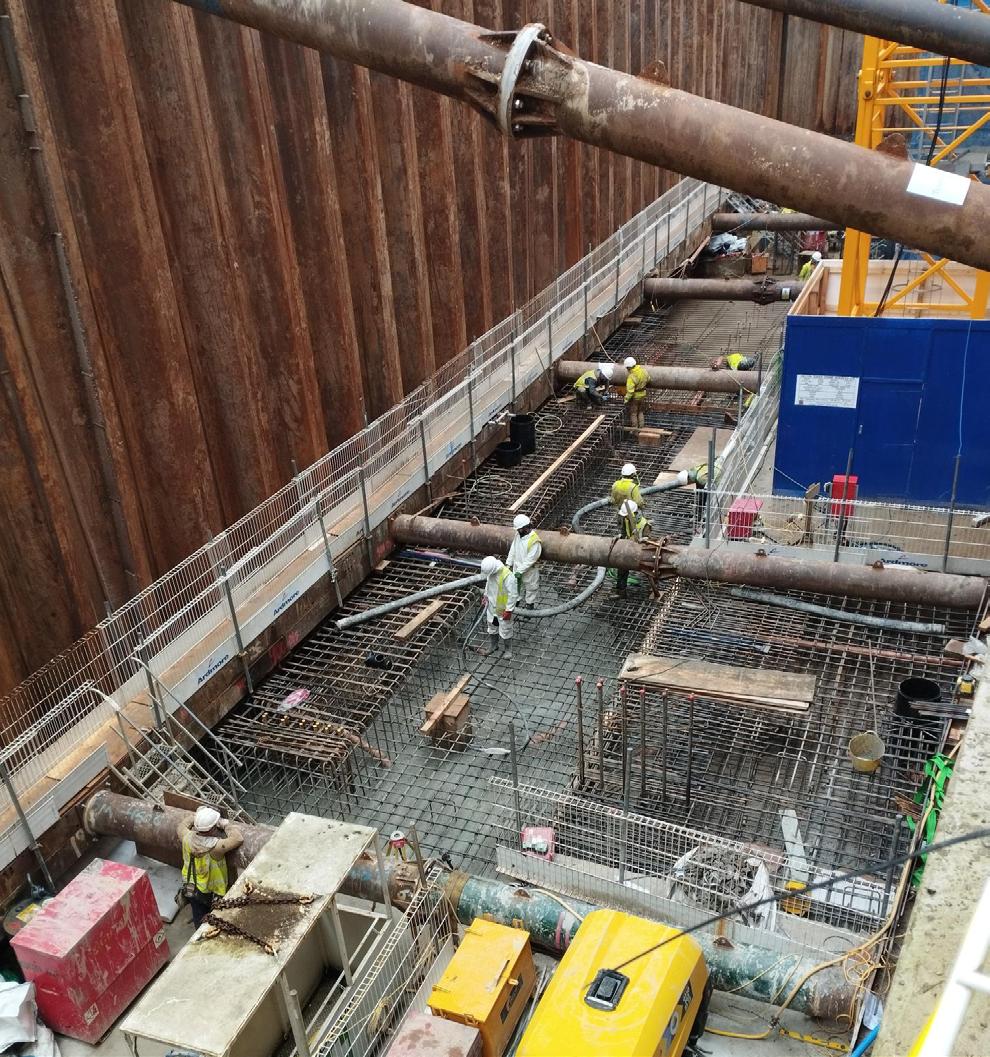



Croft Structural Engineers are the Advising Engineer for The Goring Hotel (where HRH Kate and sister Pippa spent the night before the Royal wedding). Works are being undertaken to Eaton Lane; a 3 storey deep basement constructed with Driven sheets incorporating high pressure jetting installation. The works have incorporated, movement monitoring, Meetings on site to discuss alterations to temporary works and propping. ctomlin@croftse.co.uk
44 The Pyramus & Thisbe Society
45 The Pyramus & Thisbe Society ISSUE 51 Whispers is published by The Pyramus and Thisbe Society exclusively for its members by Pongo & Matelot (info@pongoandmatelot.co.uk). All information correct at time of going to press. All rights reserved. Articles may not be reproduced without written permission from the author. While every care is taken in compiling the content, neither the publisher nor The Pyramus and Thisbe Society assumes responsibility for effects arising from this publication. The opinions and subjects discussed in this publication are for editorial purposes only. No Members nor the Fellowship of The Pyramus and Thisbe Society accepts liability for any direct or consequential loss arising from the use of this document or its contents. The opinions expressed in this journal are not necessarily the views held throughout The Pyramus and Thisbe Society. Publisher and creative direction info@pongoandmatelot.co.uk pongoandmatelotstudio Management Editorial MEMBERSHIP OFFICER Ryan Hannibal-Law email PUBLICATIONS OFFICER David Moon email IT / WEBSITE OFFICER Hannah Boyd email CHAIR Fareed Fetto email SECRETARY Matthew Briggs email FINANCE OFFICER / TREASURER Jonny Callard email EDUCATION OFFICER Stuart Birrell email Angela Gregson email EDITOR Natasha Demirbag email Allan Ssesanga email Shirley Waldron email Nick Brown email Michael Clark email We always welcome suggestions / new ideas for content and are always delighted to receive articles for publication. Please send any articles and photos to any member of the editorial team above Details of regional officers can be found on the website. Photography AdobeStock, Mockups-design.com, Shutterstock and Unsplash. Irene Moore email
ISSUE 52
















































